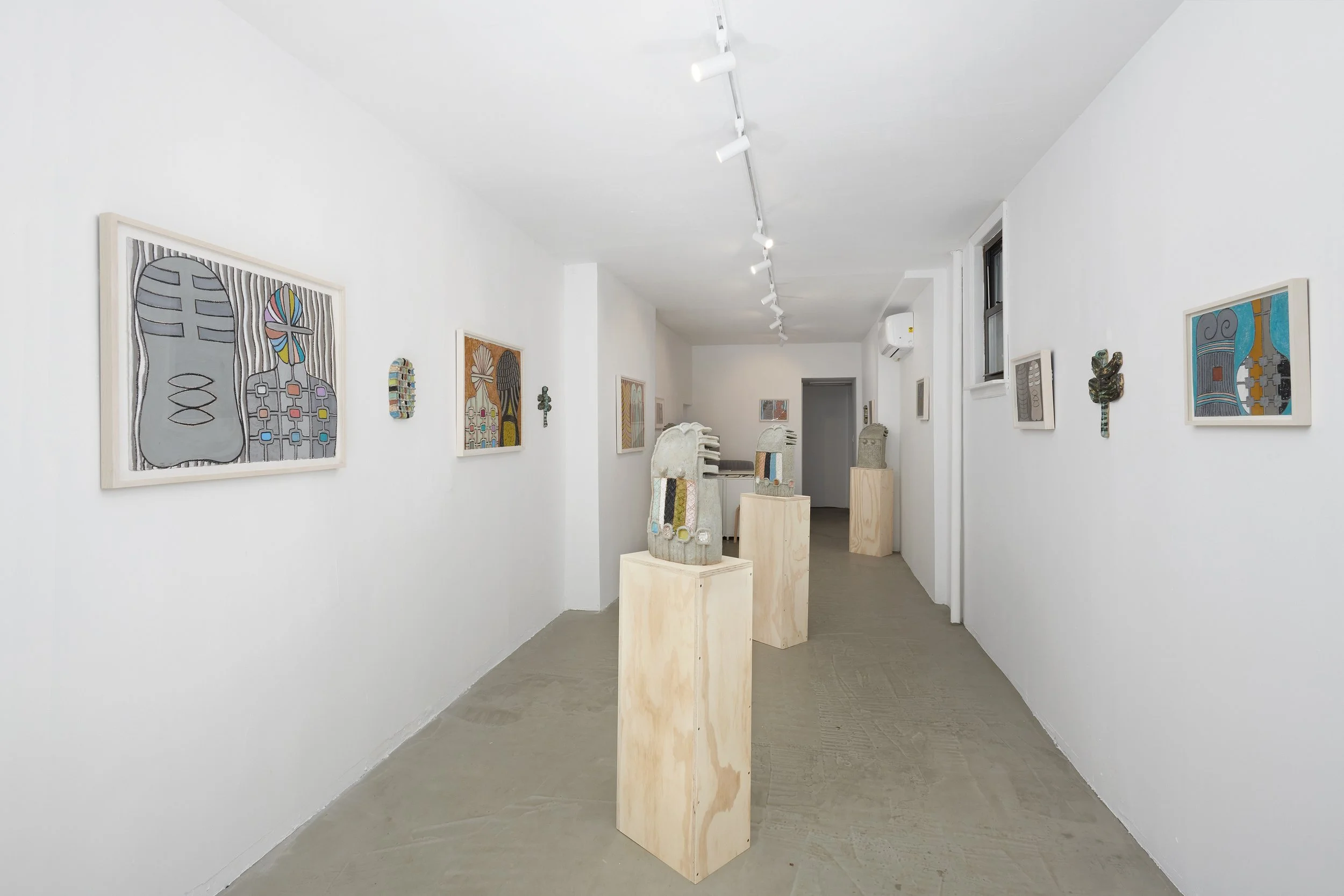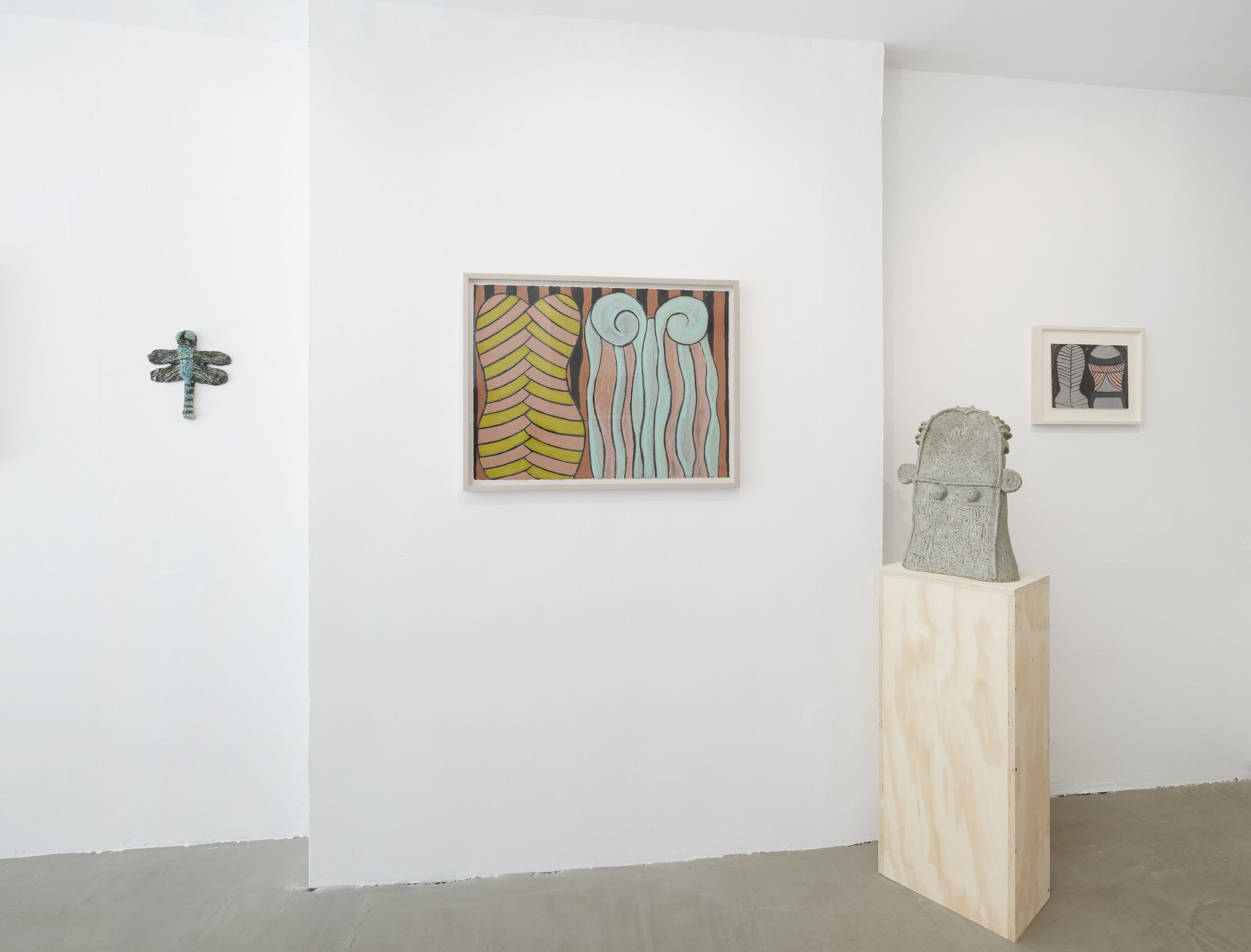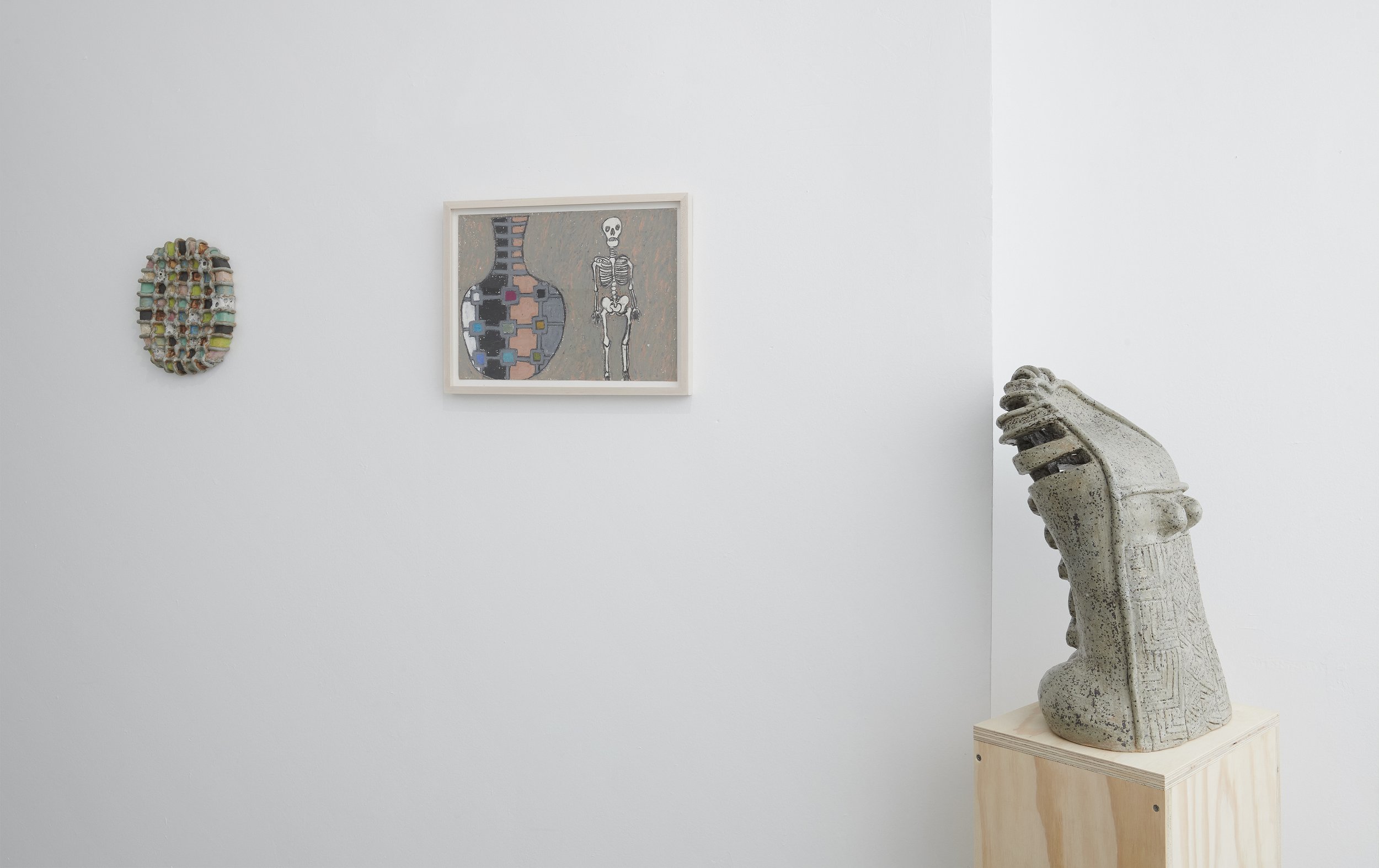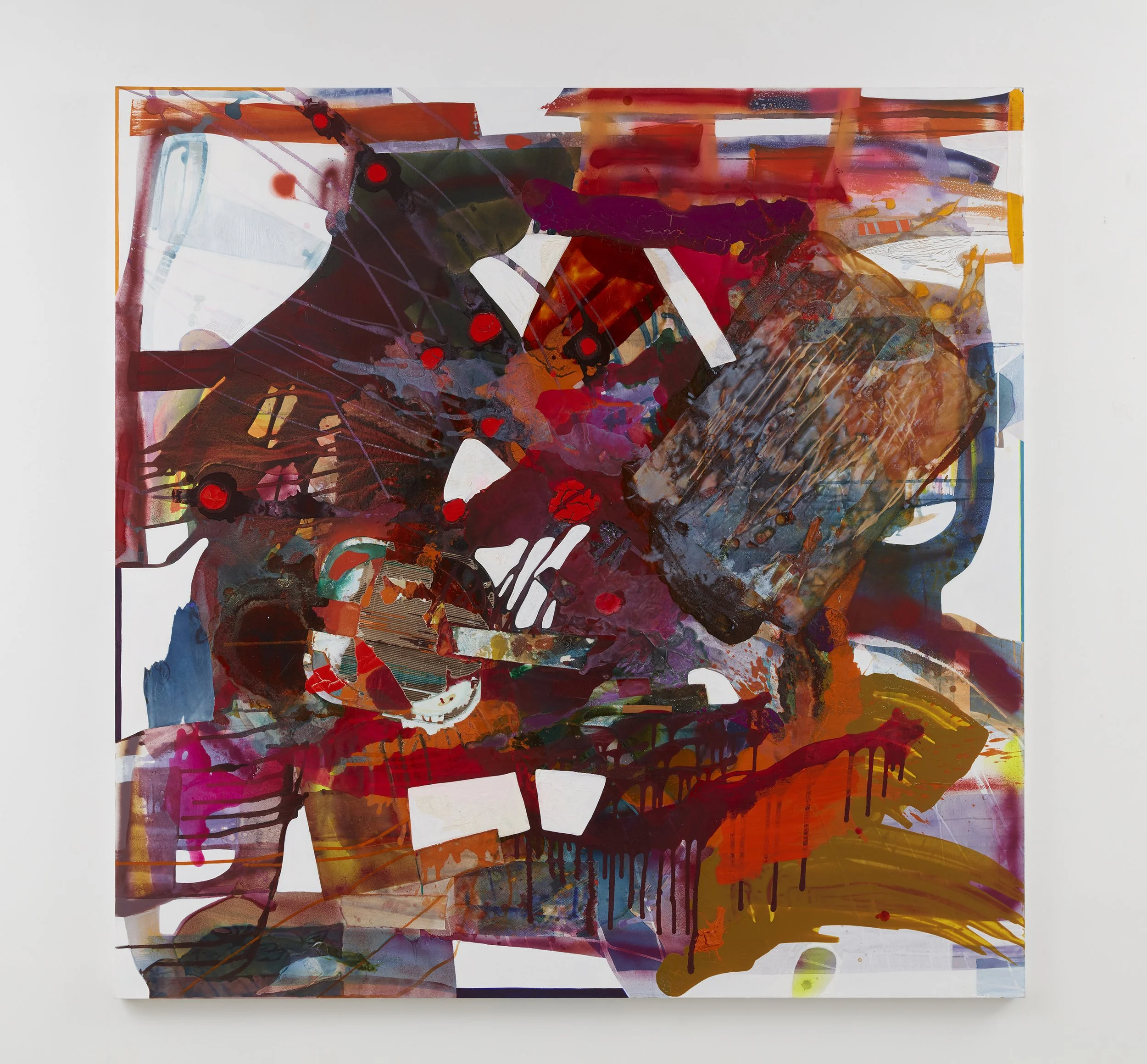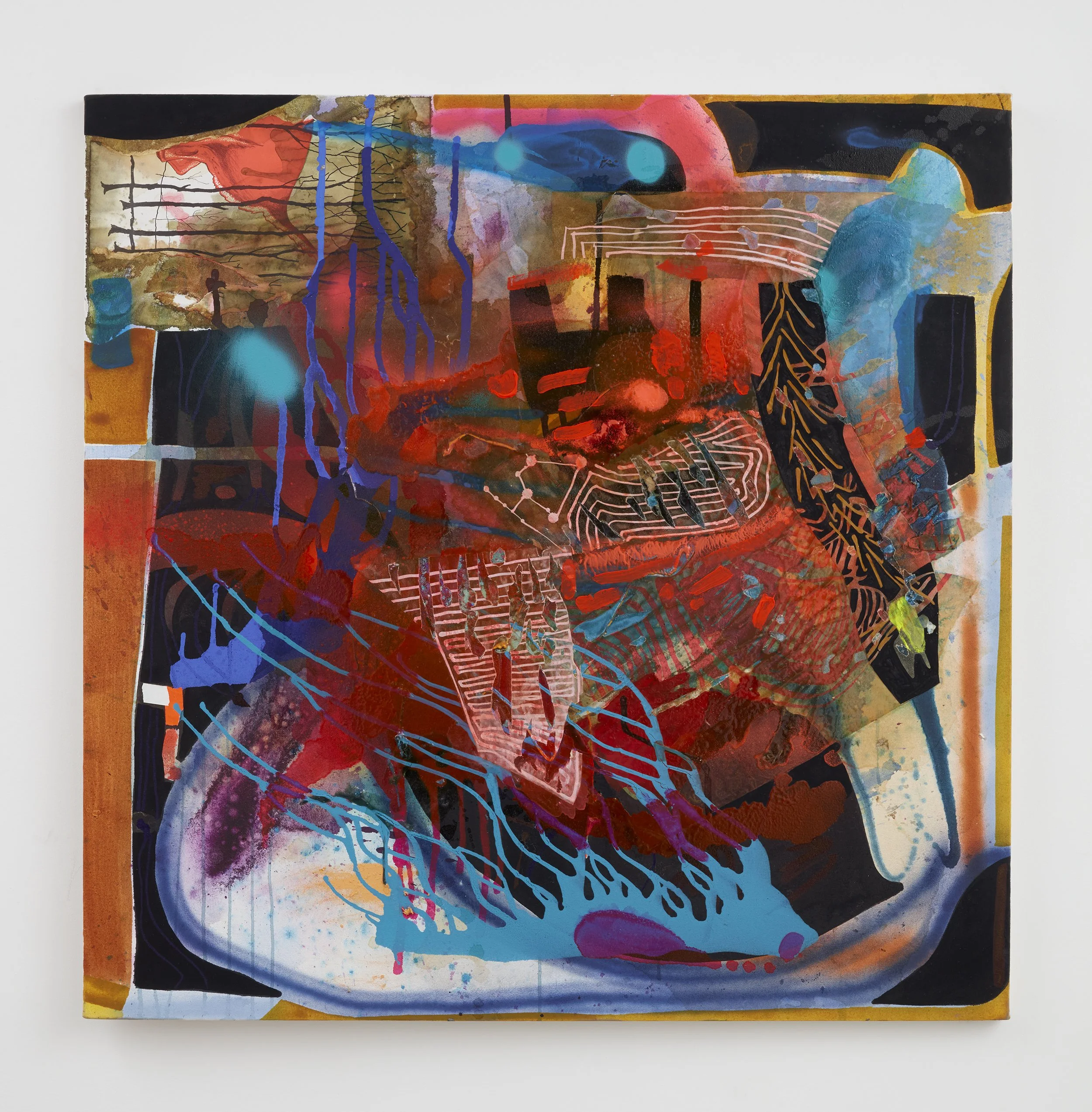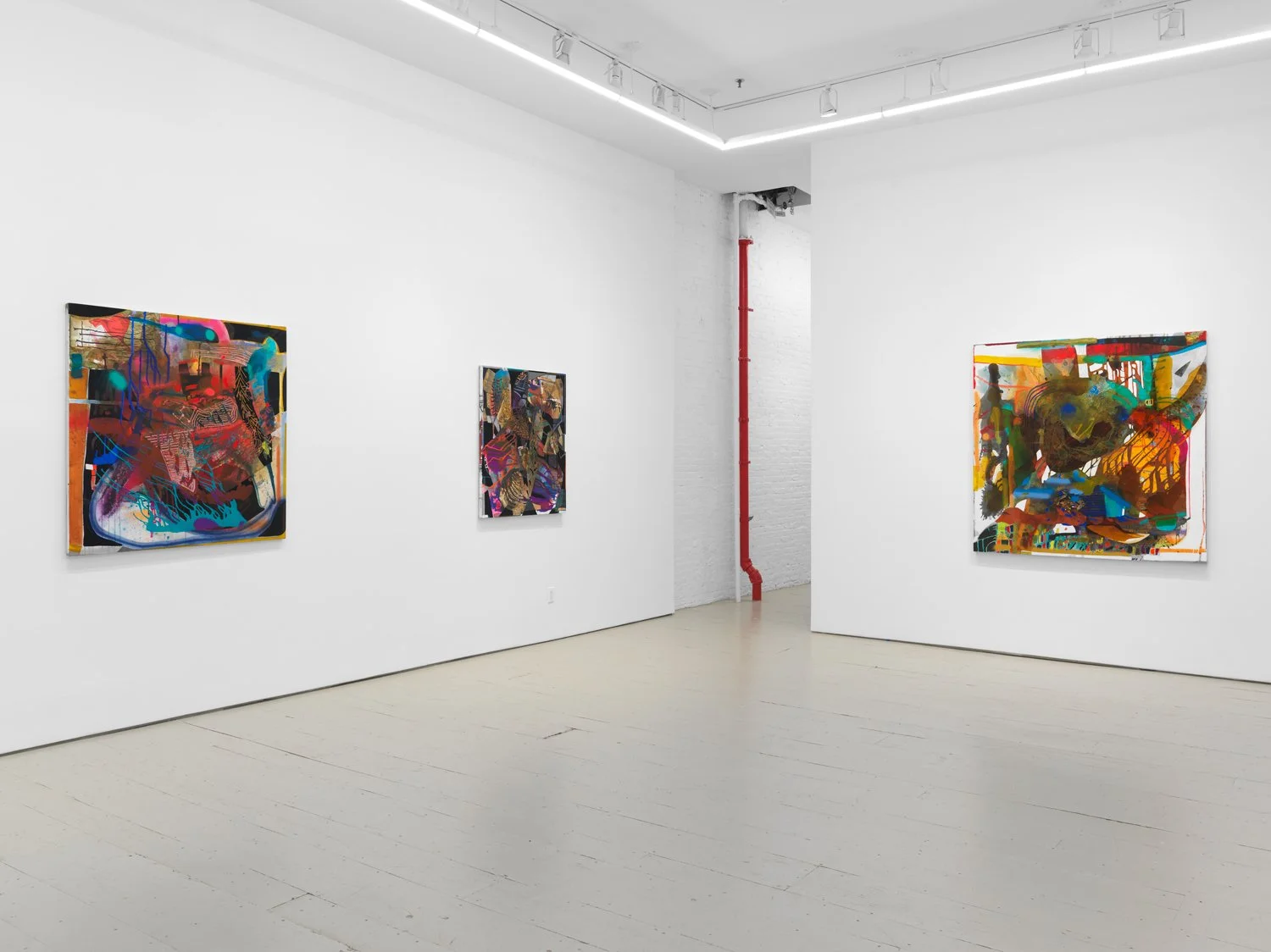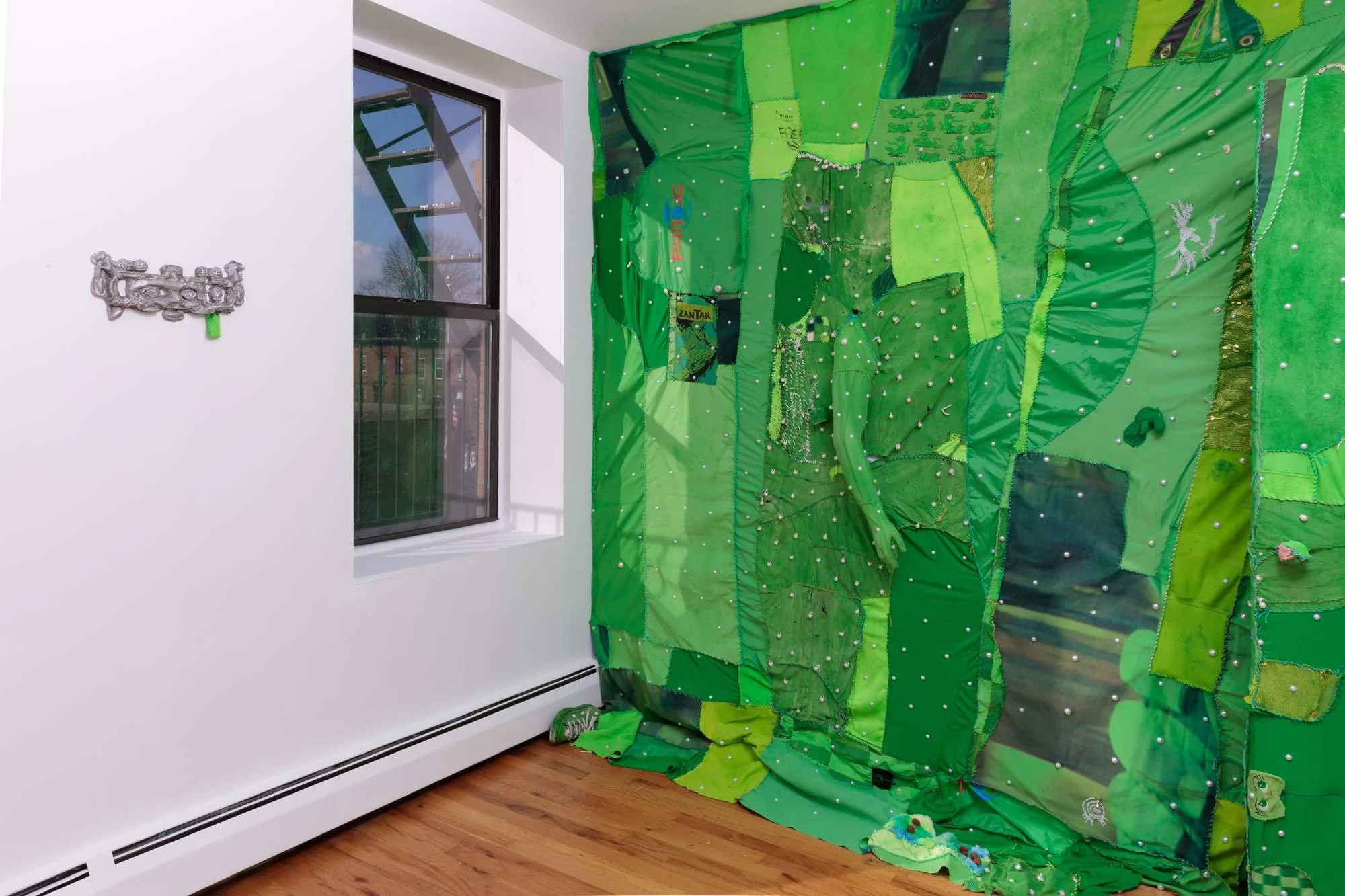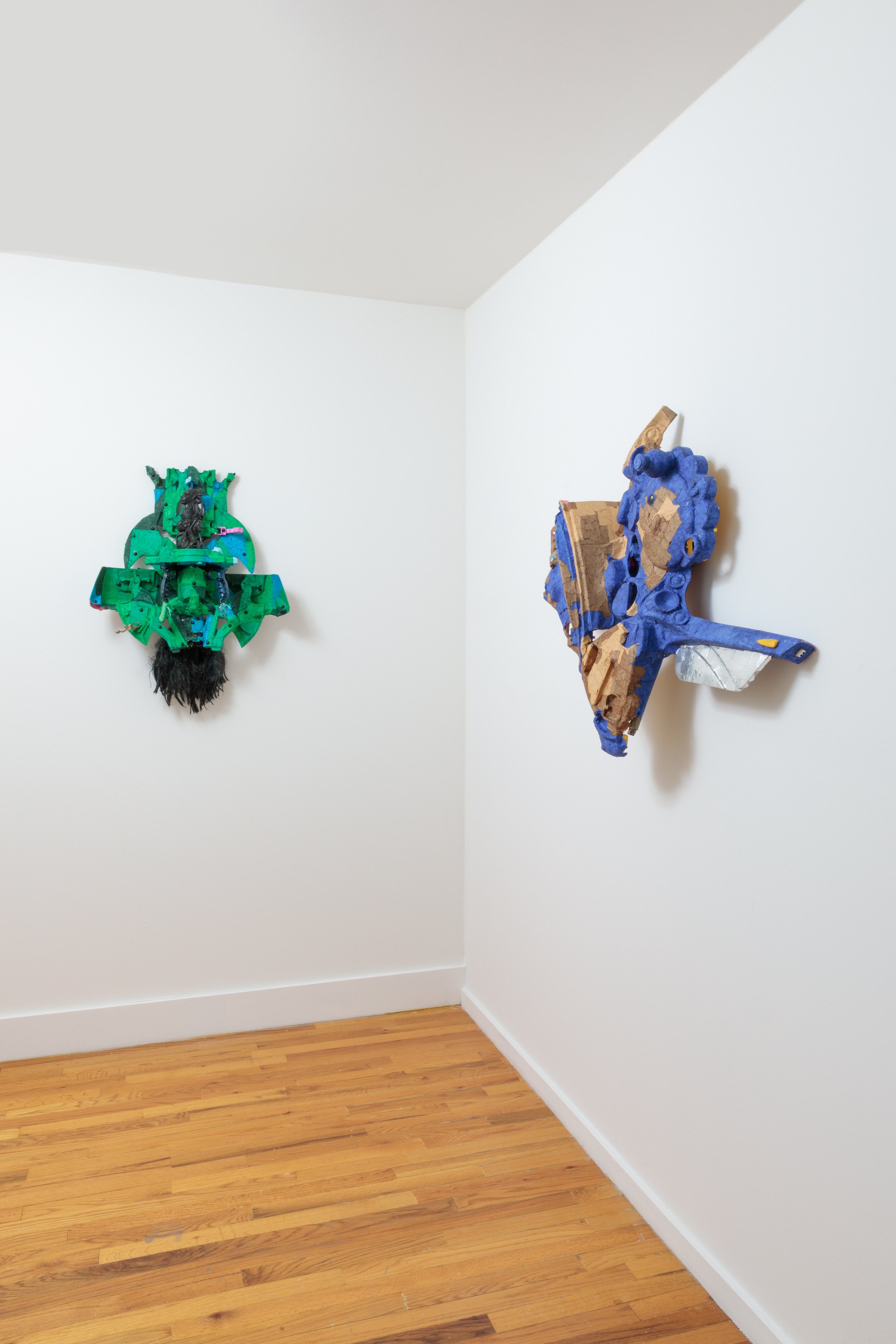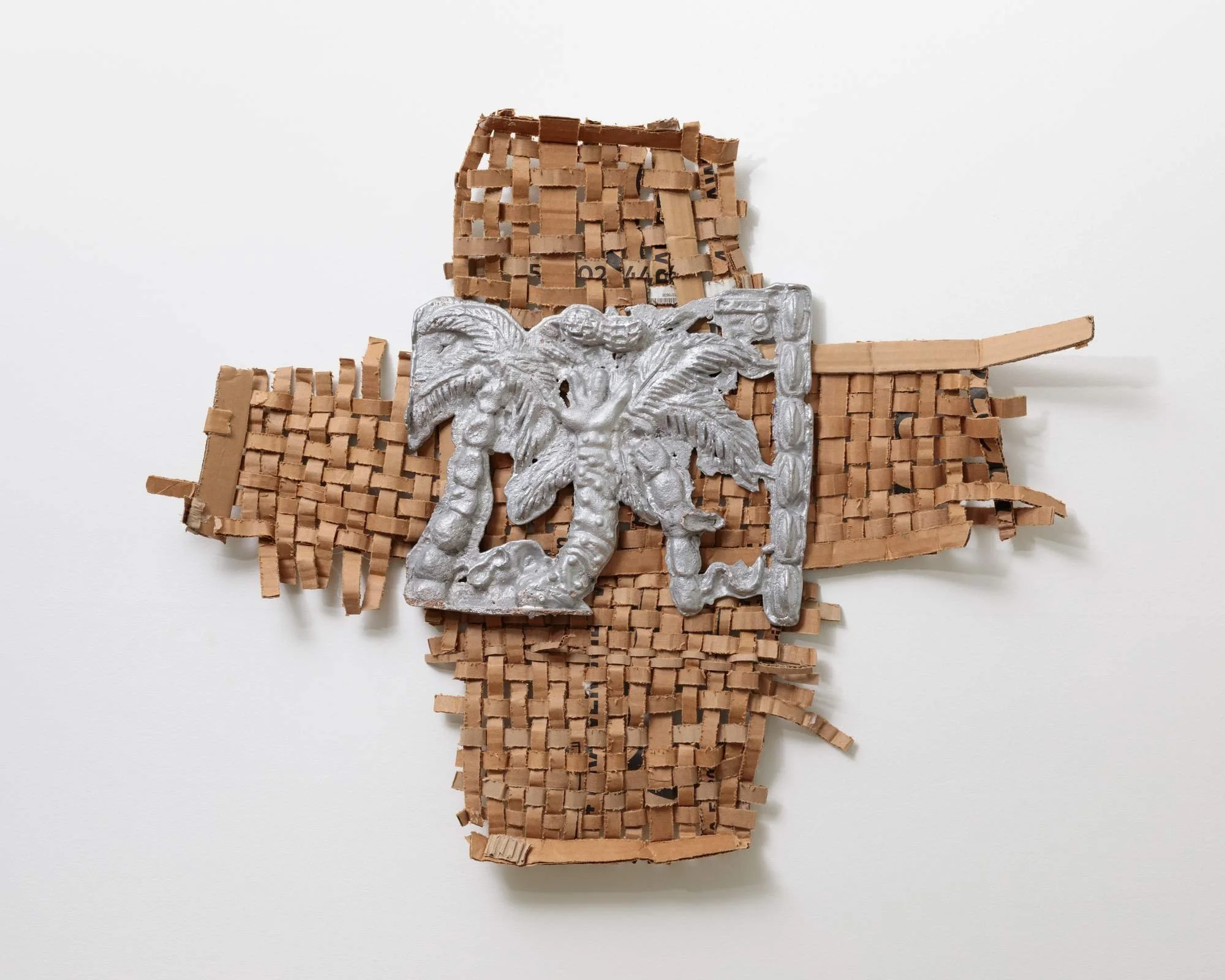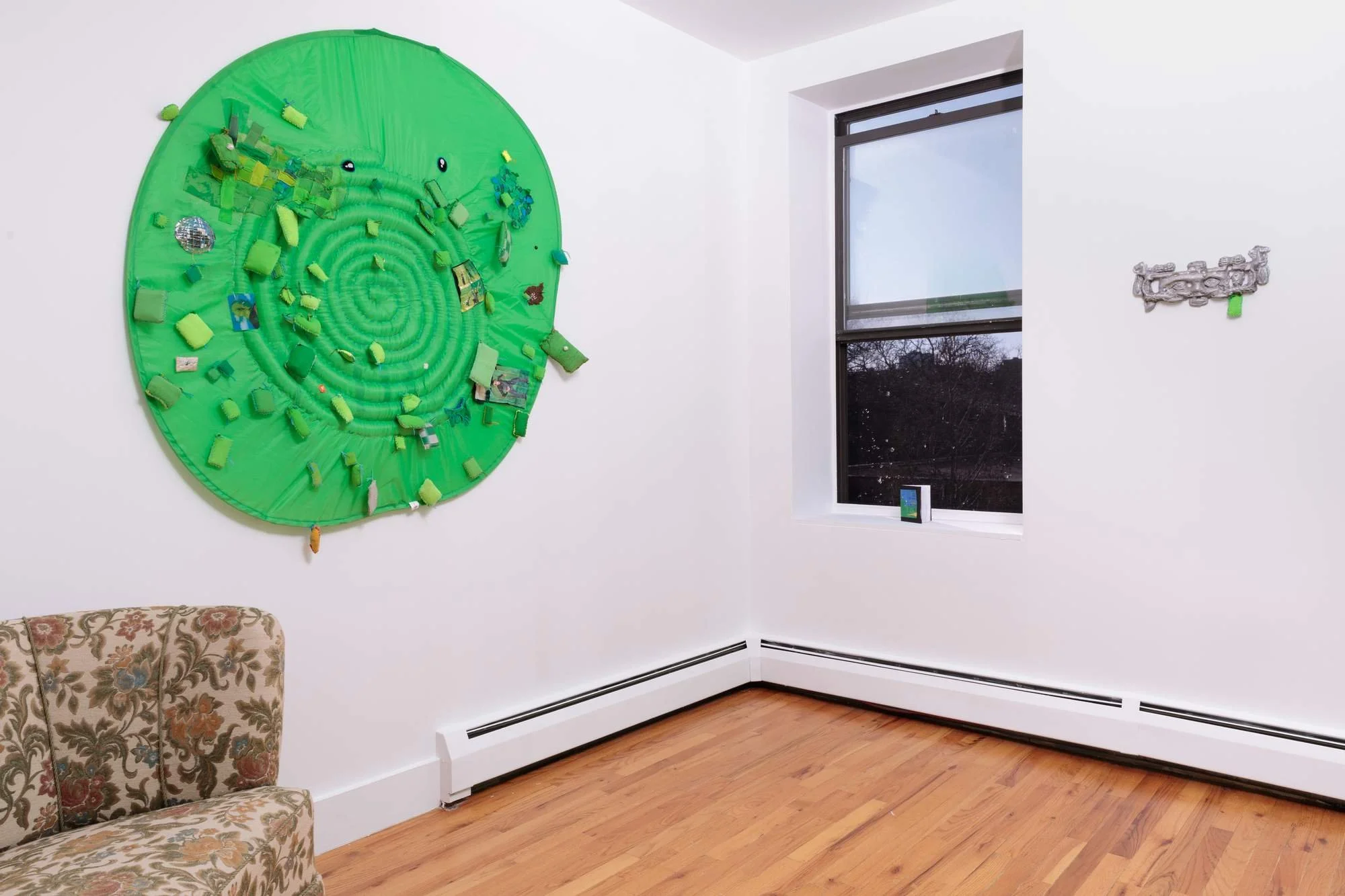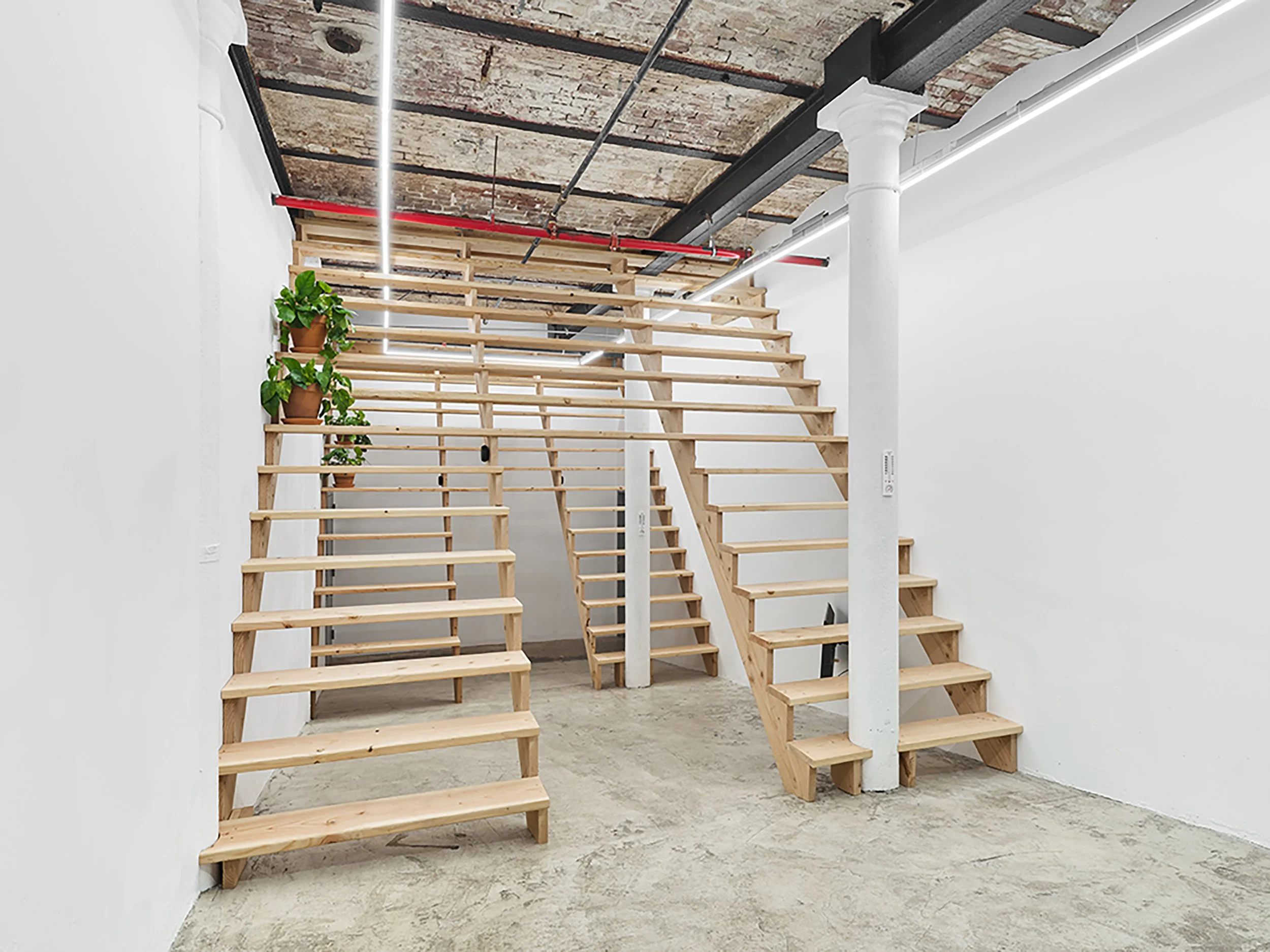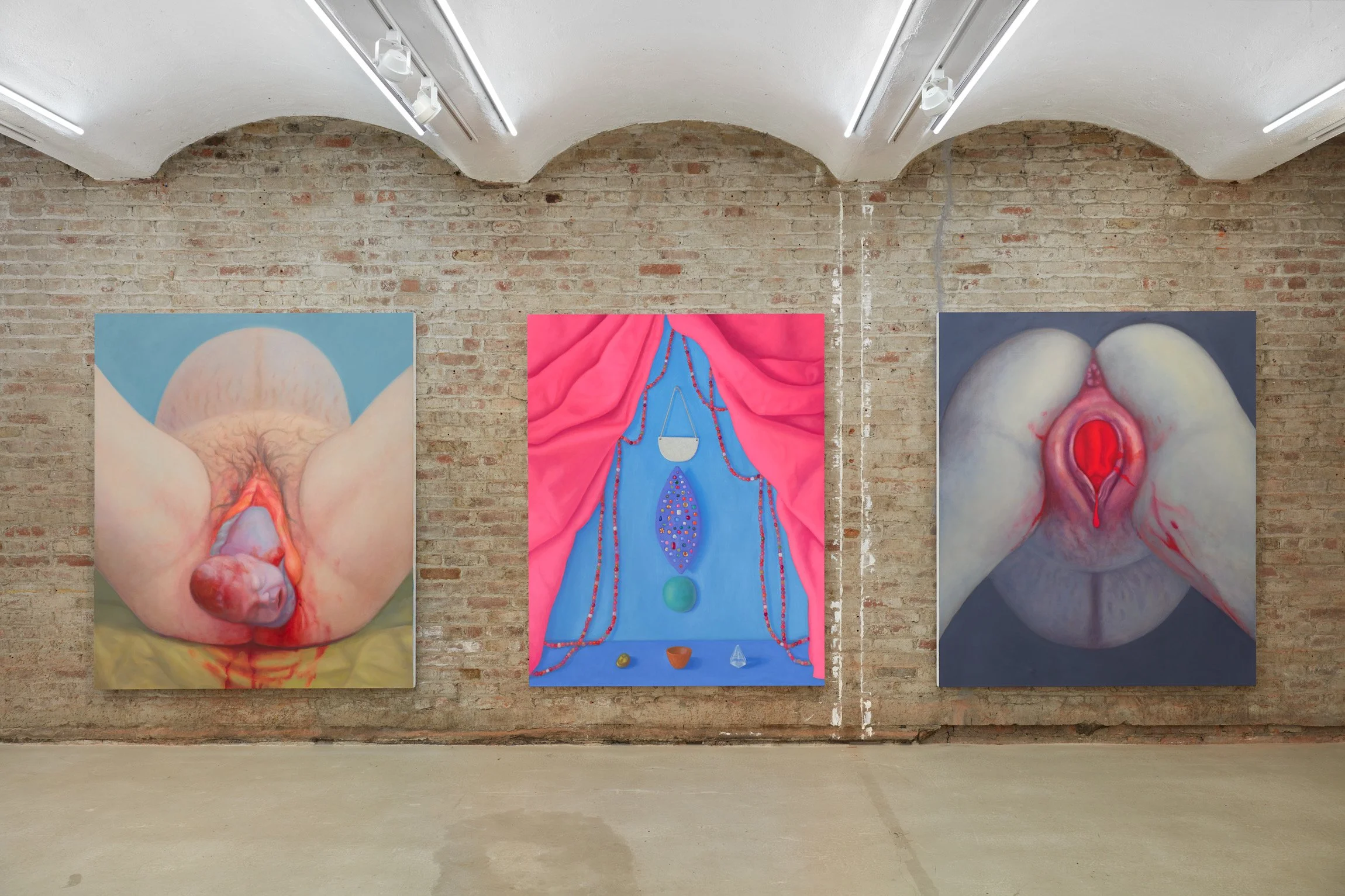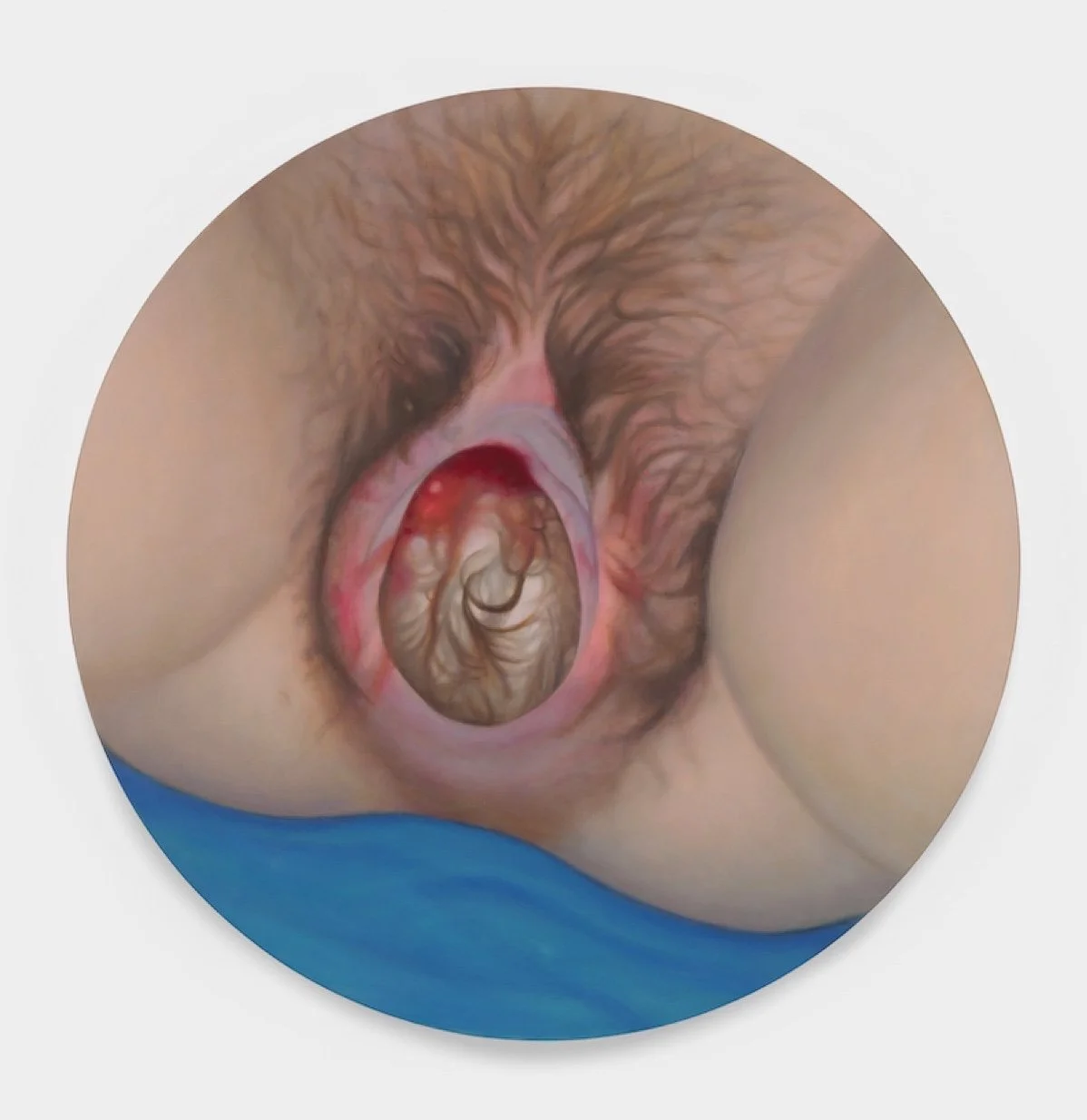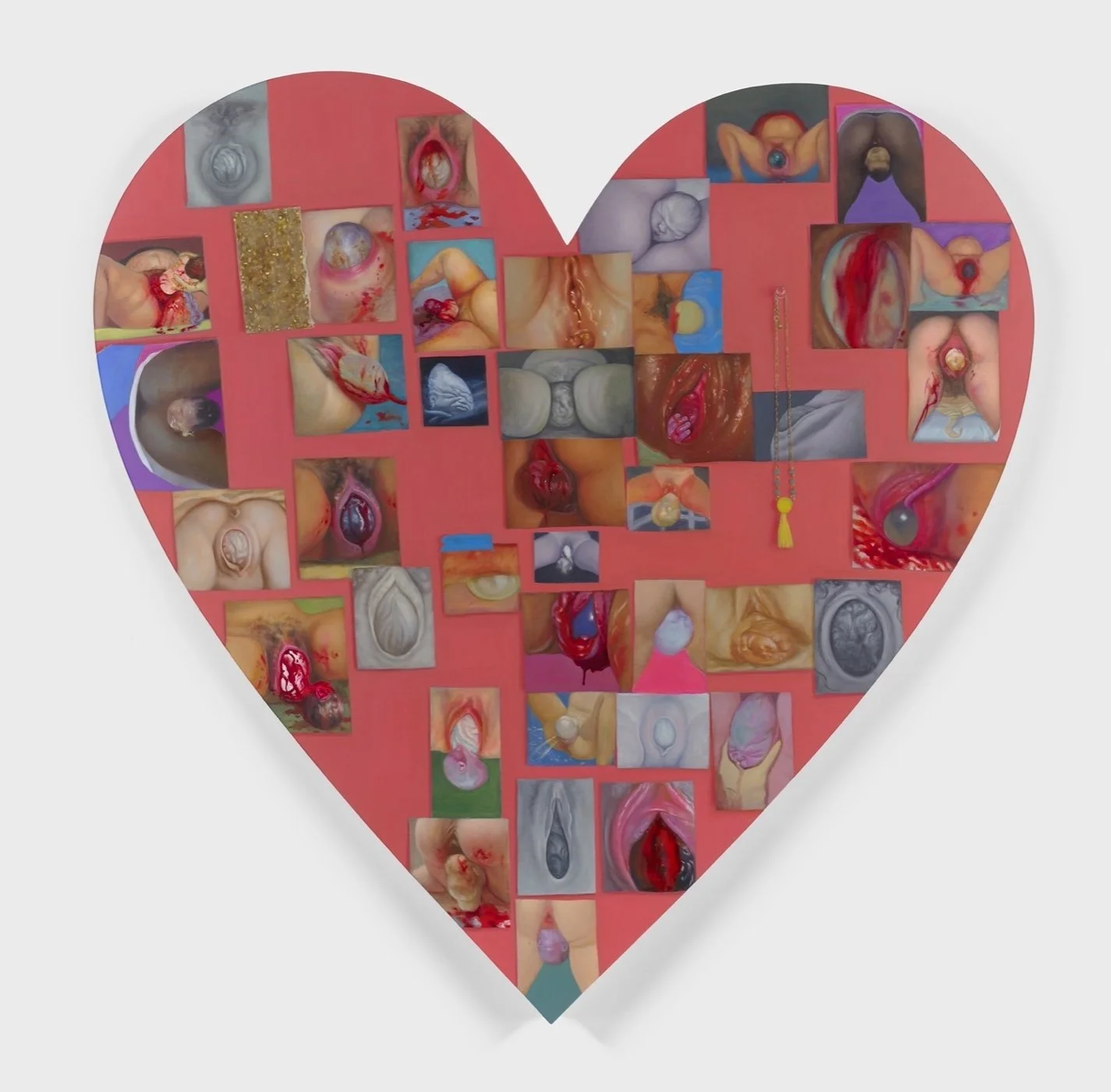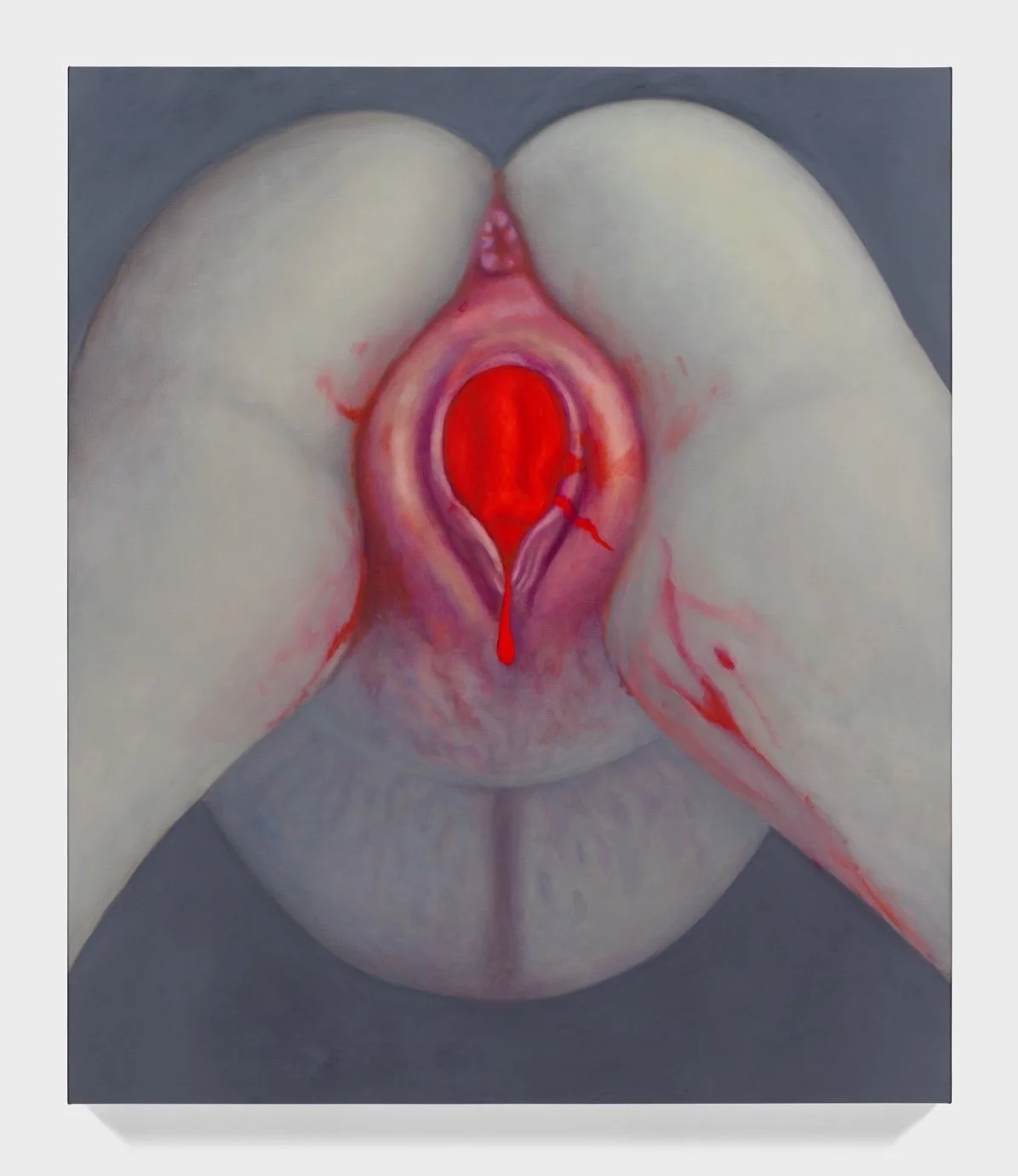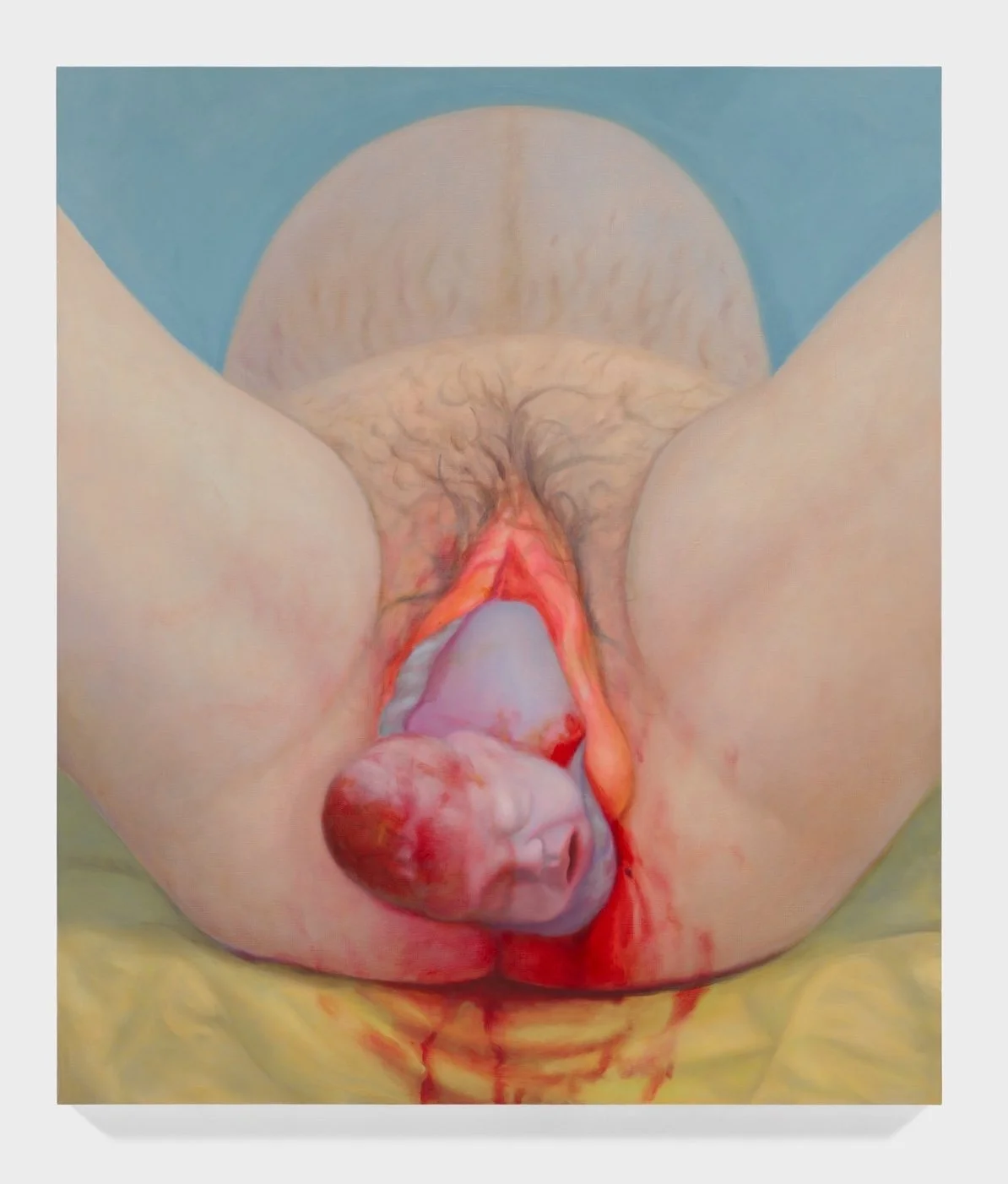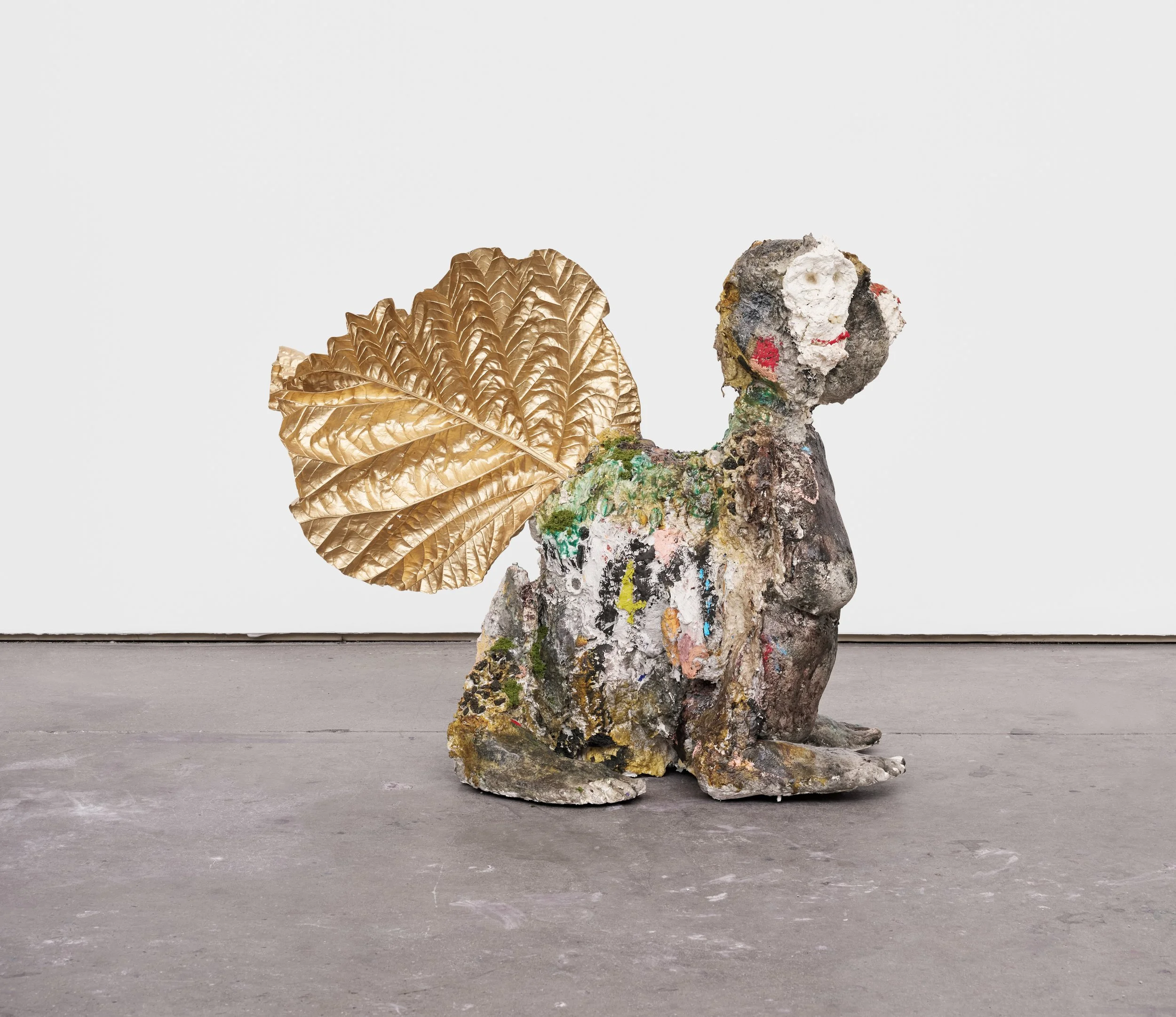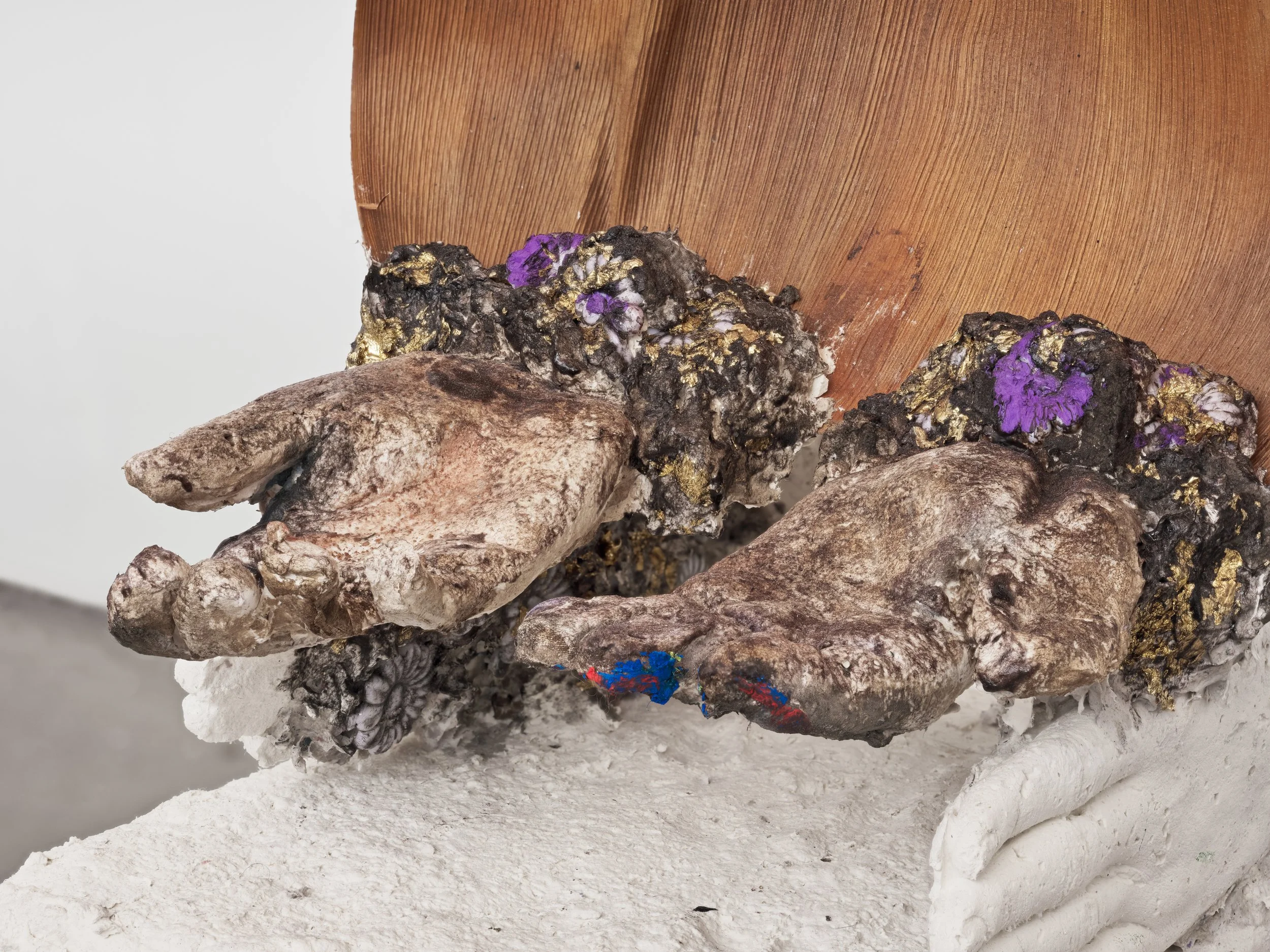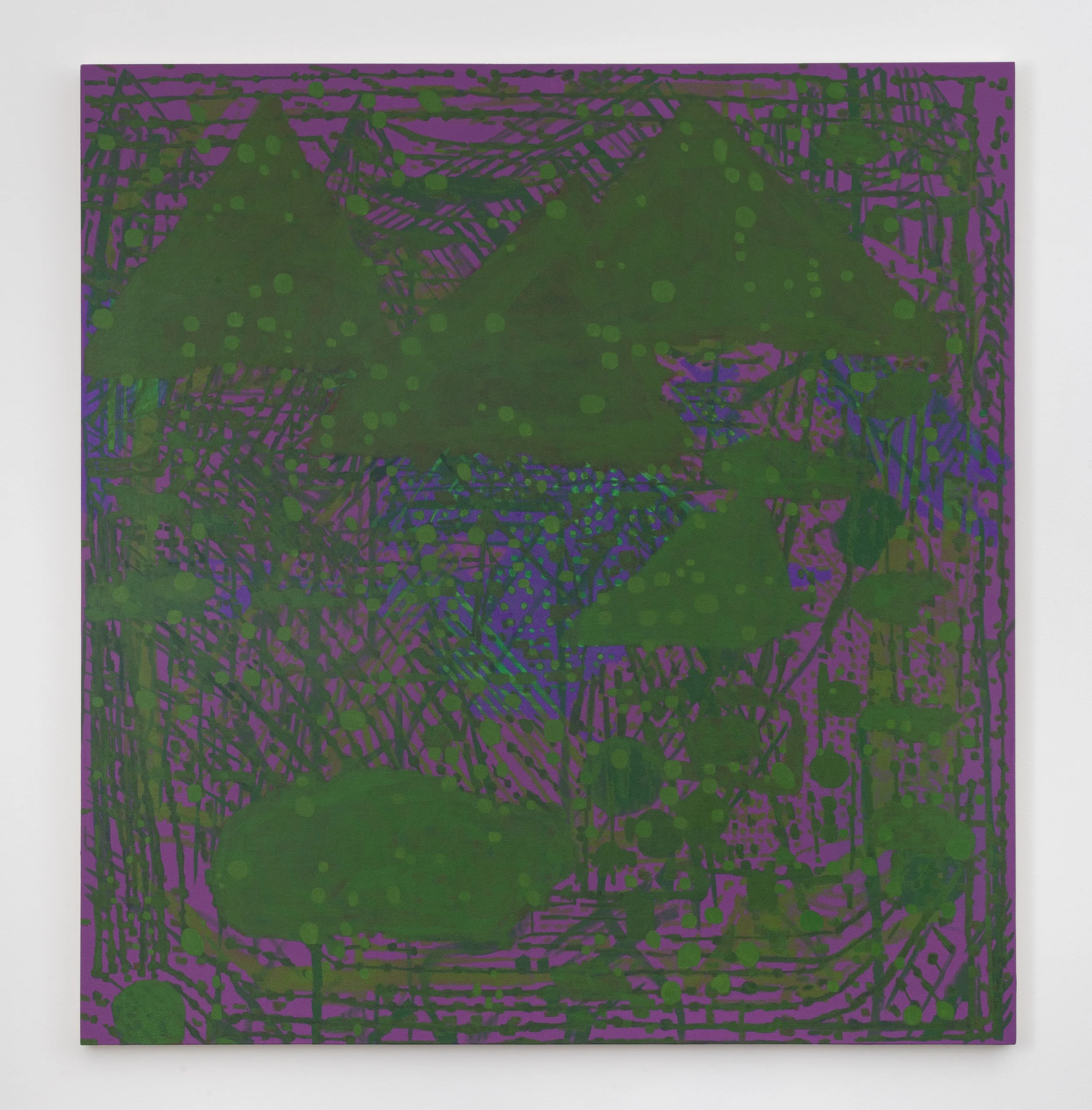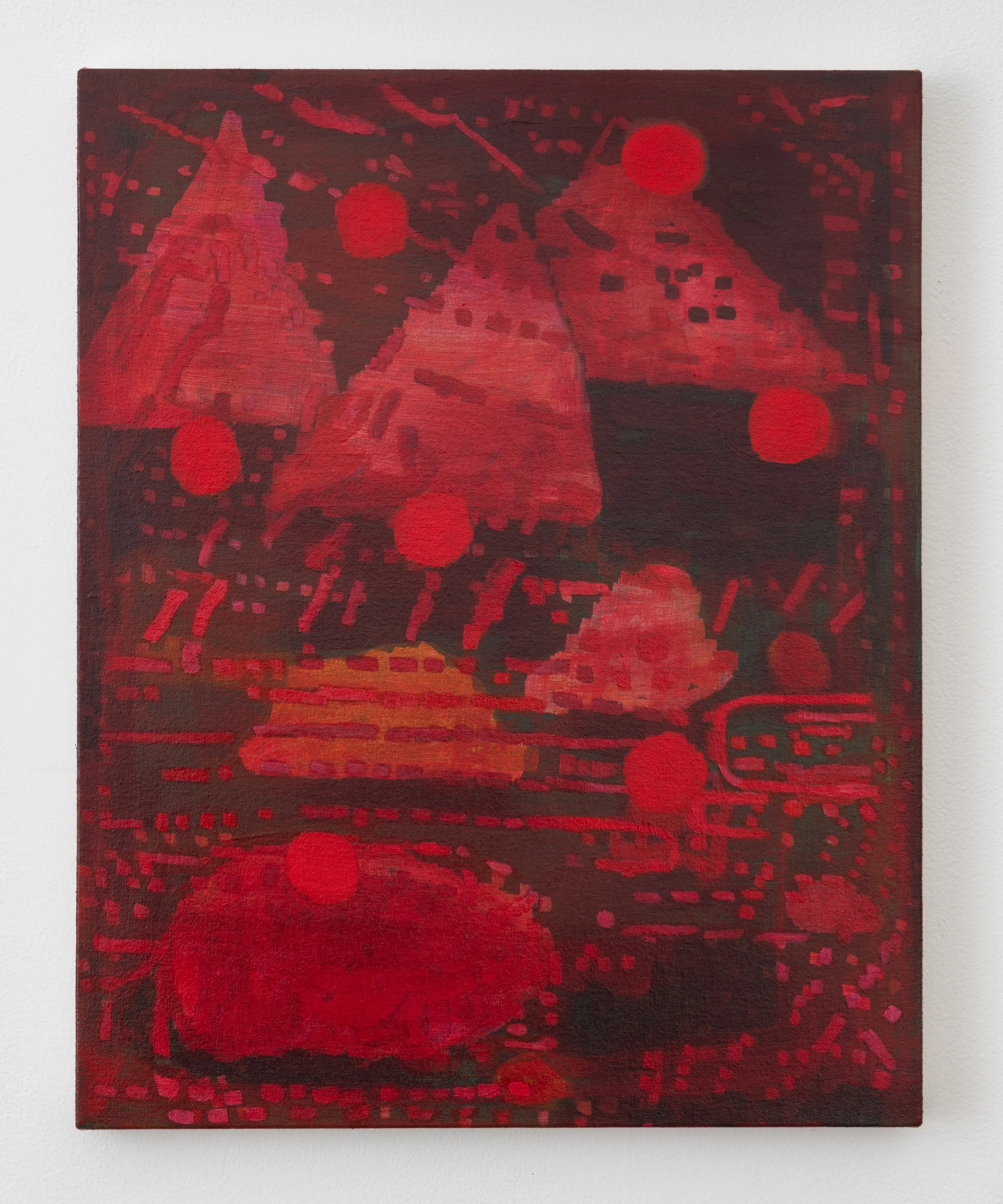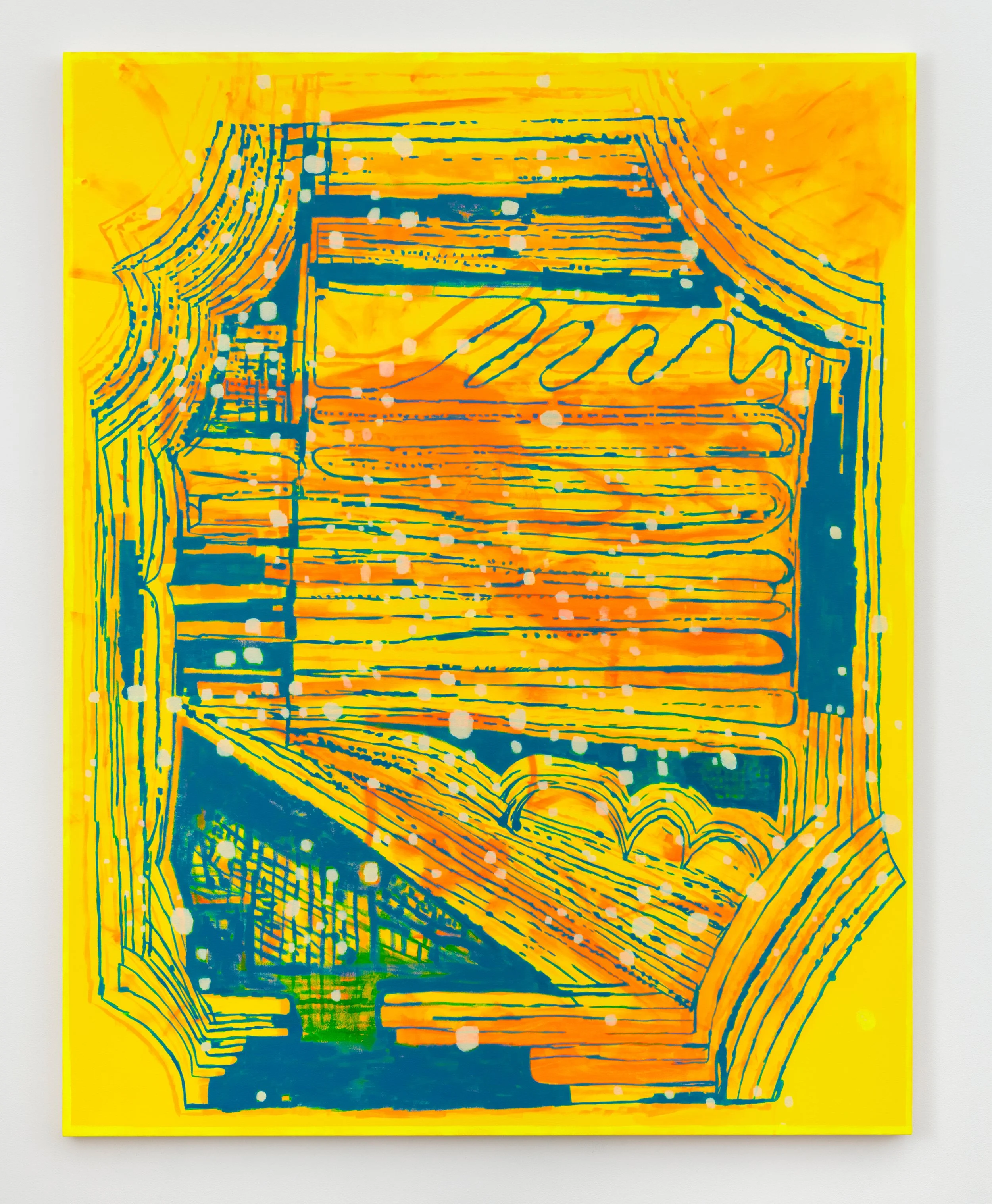EP • REVIEWS
EP • REVIEWS
Elisa Soliven’s Nagas: Tantric Maps and the Subtle Body
10.25.25
Wells Chandler October 25. 2025
Installation view of Hybrid House at McBride/Dillman New York, NY
In Italo Calvino’s Cosmicomics, the spiral is both a cosmic structure and a narrative device —the way life remembers itself through movement. In The Spiral, Calvino writes from the perspective of a prehistoric mollusk, describing the slow, repetitive labor of secreting calcium to form a shell —a gesture that is both a biological necessity and a creative act. Calvino’s mollusk narrator is an artist, a being that creates form out of itself. The mollusk chronicles, “Every turn of the spiral was a memory of the preceding one.” Its shell becomes an externalized record of inner life, a metaphor for consciousness arising through a material process.
Installation view of Hybrid House at McBride/Dillman New York, NY
Elisa Soliven’s hand-built ceramics perform a twin gesture. The five horseshoe crab busts populating her exhibition Hybrid House at McBride/Dillman are informed by a molted horseshoe crab shell encountered at Plumb Beach in Brooklyn, NY. What appears as armor in Soliven’s busts is, in fact, a gesture of letting go. It is through surrender, vulnerability, and softening that wholeness is restored. Soliven’s exoskeleton armor is porous and responsive –protective only insofar as it guides transformation. Ambiguous breasts empathically gaze –round as saucers– their eyes wide open, innocent, and tender like a child. Sparingly adorned in Wisdom Buddha colors and tattoo line work, her torsos embody the generative moment when shedding yields to renewal, exposing the gestational, receptive space within. Evoking the aquatic, her gilled busts conjure nagas –wise serpentine beings whose fluid, otherworldly anatomies recall the deep intelligence of life beyond human constraints. Each piece also reads like an ancient artifact, a relic of accumulated memory and ritual, where myth and imagination crystallize into a body that is at once familiar and uncanny.
Installation view of Hybrid House at McBride/Dillman New York, NY
An undoing of the self would be a total remembering —the recollection of all of one’s dreams at once. To restore them would be an act of power: their unspooling, event by event, an encounter with the alpha and the omega. In Soliven’s sculptural work, this re-membering is a kind of alchemical archaeology. Clay retains memory, fossilizes touch, and preserves a lineage as though every imprint and coil were a layer in the sediment of consciousness. As a palimpsest, clay is the crucible through which matter remembers itself. Ceramics as a process becomes a metaphor for psychic transformation —the old self hardens and splits so the new can emerge. Fire integrates ordeal, allowing for illumination.
Elisa Soliven “Torso & Spiral Body” (2025) oil pastel, charcoal, oil paint on paper 22 × 30 inches
Soliven’s ceramics and drawings are concerned with the great work —the realization of a self that is larger than the limitations of the body and restrictive stories told by the ego. This process involves the union of opposites. Mirroring is structural in Soliven’s drawings, aiding in integration. In her works on paper, Soliven treats the pairing of amphoric vessels, skeletons, leaves, armor, and Corinthian columns as tantric anatomical maps. Bifurcated along a central axis, they operate as a nervous system –suggesting the Ida and Piṅgalā, the dual subtle channels through which energy ascends. Each side vibrates in dialogue with its partner. The two pillars of the High Priestess card— Boaz and Jachin —also come to mind. The drawings position the viewer standing at the threshold of knowledge and nonduality. Balance is a central theme across suits in the second card of the tarot, which mediates polarity and receptivity. Through doubling, Soliven’s work becomes a ritual apparatus: the self reflected in the other, consciousness mirrored in matter. Her drawings are instructions for psychic and material metamorphosis. Relational transformation arises through mirroring —the capacity to see oneself in the other, and the other within oneself. The space between them —the void, the axis, the spiral —is the nexus where change happens.
Installation view of Hybrid House at McBride/Dillman New York, NY
In Soliven’s installation her busts reverently face Aster Body Totem –a large ambitious ceramic work topped with a spiral finial, composed of five stacked columns bejeweled with a keloid-like map of colored disks suggestive of nadis —the architecture of the subtle body. The Sushumna is the central energy channel in yogic and Tantric traditions. Running along the spine and through the chakras, it is the primary pathway for spiritual awakening. By balancing the Ida and Piṅgalā through meditation, Kundalinī energy rises from the base of the spine to the crown of the head leading to liberation and higher consciousness. The structure of Soliven’s sculpture suggests a being simultaneously dissolving into rainbow light and coalescing lunar with solar —a vessel whose body contains multiplicity and complexity. In Aster Body Totem, Soliven gives form to the paradox of contraction and expansion — the spiral that is both finite and infinitely vast, serving as a bridge for both the microcosmic and macrocosmic. Inward implosion and outward flowering evoke the primordial matrix through which all forms are generated, destroyed, and reborn. Hybrid House is a devotional remembrance that we are ancient and future, container and conduit, self and other.
Installation view of Hybrid House at McBride/Dillman New York, NY
Elisa Soliven: Hybrid House at McBride/Dillman (195 Henry Street New York, NY 10002) through October 26.
Marta Lee’s Altars: Pattern, Synchronicity, and Sacred Time
10.22.25
Wells Chandler October 22. 2025
Installation view of 11:11 at Tappeto Volante Brooklyn, NY
In Beautiful Necessity: The Art and Meaning of Women’s Altars, queer folklorist Kay Turner proposes that altars are relational assemblages: sites where women arrange objects of memory, desire, grief, and celebration into visual matrices. Beyond ritual objects or religious furnishings, Turner emphasizes that altars blur the boundary between the sacred and the everyday. A pressed flower, a family photo, a toy, or a scrap of fabric might carry as much devotional weight as a saint’s icon or relic. What defines the altar is not the sanctity of its contents but the act of arrangement itself. The ritual placing of things produces a charged space housing presence and practice.
Marta Lee, “Old and New Order (Diary)” (2024) acrylic, pastel, crayon, & oil on linen 47 × 35 inches
From this perspective, Marta Lee’s paintings may be read as altars in themselves. Her canvases cull heirlooms, quotidian objects, textiles, and mementos into carefully composed yet intuitively open constellations. Just as Turner proposes, Lee’s paintings collapse distinctions between the mundane and the precious, the secular and the sacred. An Easter egg, a childhood hacky sack, or a record player coexist with family textiles and cherished albums, each transformed into pattern and color, each granted equal being.
Marta Lee “Rainbow (Around Her Neck)” (2024) acrylic, crayon, & graphite on linen over canvas 58 × 54 inches
In Lee’s paintings, flattening is not only formal but metaphysical. It is a way of transforming objects into a unified field. Lee’s commitment to flattening can be understood as an insistence on presence. On a microcosmic level, this mirrors the structure of reality itself. We are atoms and energy, illusionistically contained in separate forms defined by stories, relations, and perception, yet ultimately part of one continuous field.
Marta Lee “What I Want (to Paint)” (2025) acrylic, crayon, & flashe on panel 54 × 38 inches
Atomically we are all made of the same stuff. This truth is reflected structurally in Lee’s work; the objects composing her still lifes exist on the same visual plane. By refusing volumetric illusion, she forces the viewer into direct encounter with what is. Opening oneself to the ordinary becomes a vehicle for awareness —a contemplative practice anchored in the everyday. This resonates with the praxis of painters such as Lois Dodd, Josephine Halvorson, and Catherine Murphy, who all privilege the overlooked stuff of daily life, painting what is immediately before them in a straightforward way. Lee’s sensitivity to the intimate drama of ordinary objects links her to Horace Pippin and Dawn Clements, who both turned sustained observation into a devotional act —transmuting the commonplace into a record of presence and feeling. In Lee’s work, presence is achieved through the full immersion into the surface of things, the quiet insistence of the here-and-now as a meaningful encounter.
Marta Lee “I practiced the color names while she played solitaire (Day and Night)” (2024) acrylic, crayon, pastel, & oil on canvas 48 × 60 inches
Lee’s paintings can be framed as nowness time-capsules. Each canvas compresses and collapses multiple temporalities —childhood toys, heirlooms passed down through generations, seasonal decorations, and contemporary objects coexist creating a ritual center, where time is not linear but synchronic, woven together through pattern. As with altars, Lee’s paintings create an axis mundi —a site where disparate timelines meet, where the circadian is sanctified through visual ordering, and where memory becomes present. Linear time collapses in, I practiced the color names while she played solitaire (Day and Night). Past, present, and future exist concurrently. A view out the left window depicts day, while the view out the right reveals that it is also night.
Marta Lee “Prospect Park Kunstkabinett” (2025) acrylic & crayon on linen 60 × 48 inches
Carl Jung defined synchronicity as the occurrence of two or more events that are significantly connected without a causal relationship. Acausal connecting principles reveal the psyche’s participation in a larger web of meaning. In Lee’s work, synchronicity emerges through the visual logic of pattern recognition. By flattening objects into ornamental lattices and idiosyncratic shapes, Lee draws out archetypal echoes —a record becomes a spiral, its hypnotic form guides us inward and outward. Baby blankets become soft ordering grids. A clown becomes a guardian. The flower’s petals on an album-cover rhyme with a fragment of foil. The syntax of these relationships invite viewers to perceive connections across objects, histories, and emotional registers that would otherwise remain invisible. The repetition of certain motifs across her work —the reappearance of hacky sacks, family textiles, or music —becomes a kind of visual synchronicity. The same objects resurface in new contexts, anchoring the viewer and charging the talismans through relational layering —transforming them into ritual tools.
Marta Lee “Someone More Thoughtful (Here Goes Everything)” (2021) acrylic, crayon, & flashe on linen 34 × 40 inches
Pareidolia, the human tendency to perceive faces or meaningful forms in random or ambiguous patterns, offers a useful lens for understanding Lee’s subtle incorporation of figuration. Lee distills psyche in her still lifes. Dangling red and blue ties form parallel suspended smiley faces in Prospect Park Kunstkabinett. Chinese White gouache signifying the mixed race of the artist, hovers above a grinning chocolate chip cookie in Someone More Thoughtful (Here Goes Everything). The hermetically sealed tube of paint is the bridge to an electric keyboard nestled in an undulating border of brown and black op art checkers floating on a sea of electrifying blue flashe. Anthropomorphic hints appear in an embedded egg nestled in a cozy mug anchoring the viewer in moments of gentle humor or playful recognition. Identity dissolves into a fruit salad collective in Mixed. In Lee’s work, each object—whether animate, inanimate, or partially anthropomorphized —functions both as a container of individual experience and as a reflection of awareness itself, melting across forms and patterns, pointing to a seamless continuity uniting apparent separations through drops —the form and substance of paint.
Marta Lee “Mixed” (2025) acrylic on linen 7 × 5 inches
In Lee’s paintings, the act of recognizing pattern becomes a reflexive gesture—awareness recognizing itself reflected through form. When objects are flattened into motifs and repeated across the canvas, they cease to be fixed representations and instead reveal the foundational structures that connect them. The act of perceiving these patterns becomes a kind of feedback loop, where looking discloses the way perception organizes itself. In this sense, the paintings operate less as depictions of things and more as reflections of the mind’s own ordering principle—anchors that hold together memory, intimacy, and time within a unified field.
Marta Lee “A Very Dear Christmas” (2025) acrylic & crayon on linen 20 × 24 inches
The title of Lee’s exhibition, 11:11, underscores these themes. In contemporary spiritual and popular culture, 11:11 is often understood as an angel number —a moment of heightened alignment in which inner and outer worlds briefly mirror each other. To notice 11:11 on a clock, is to experience a synchronicity that signals guidance or an opening between realms. Lee’s still lifes are moments where seemingly disparate objects and timelines align. Her intimate paintings are homages to the phenomena of connection, the tender moments that point to a veiled structure of reality, and the miracle of our existence that tethers us to ourselves and each other.
Installation view of 11:11 at Tappeto Volante Brooklyn, NY
Marta Lee: 11:11 at Tappeto Volante (126 13th Street, Brooklyn, NY 11215) through November 2.
Brenda Goodman, Mala Iqbal, Angela Dufresne: 3 friends
9.7.25
Wells Chandler September 7. 2025
Installation view of Brenda Goodman, Mala Iqbal, Angela Dufresne: 3 friends at 1053 Gallery Fleischmanns, NY (photo Manal Abu-Shaheen)
Jim Henson’s 1977 holiday classic Emmet Otter’s Jug-Band Christmas is a parable about love, creativity, and the joy of relationships that make life meaningful. The heartfelt story culminates with a talent contest. Wendell Porcupine, Harvey Beaver, and Charlie Muskrat assembled by Emmet Otter, form the Frogtown Hollow Jubilee Jug Band. As it goes, their performance, luminous and sincere, is overshadowed by the flashy, Riverbottom Nightmare Band. But in the end, that loss does not matter, because what they made was real. Their cooperation and effort touched each other, gave voice to care, and opened the heart. In this light, a stone's throw from the center of the art world, Fleischmanns, NY becomes its own Frogtown Hollow, a quaint town in the Catskills with a rustic spirit. Likewise, the upstate exhibition 3 friends at 1053 Gallery featuring the work of Angela Dufresne, Brenda Goodman, and Mala Iqbal, centers the importance of friendships in sustaining a longstanding art career and celebrates the gratification of creating both alongside and within a community.
Brenda Goodman, “Self Portrait 54” (2006) oil, wood, paper mache on wood 29 x 30 inches (detail)
The exhibition and the film both echo the Gift of the Magi motif; individual sacrifice results in something more meaningful to one another. In Jug-Band Christmas, Emmet and his Ma give up their respective tools, not knowing the other is doing the same, to support each other’s dreams. Their acts of love cancel each other’s plans, but reveal something truer: love itself is the gift, not the prize it helps acquire. Similarly, 3 friends prioritizes collaboration and relational care – queer feminist strategies of survival – and in doing so dismantles the lonely modernist myth of the hermetic genius. 3 friends foregrounds the reality that artists do not emerge from a vacuum. We live entangled lives, our work is informed and enhanced by each other. Making kin is part of staying with the trouble.
Brenda Goodman, Angela Dufresne, Mala Iqbal “Sap Stalk Scion” (2025) oil on wood with branch 60 x 72 inches
The exhibition features collaborative works and individual ones. Rife with Pinecrone proverbs, a video shot by Linda Dunne, Goodman’s partner of forty plus years, documents the artists collaboratively painting Sap Stalk Scion 2025. Subverting the dominant narrative of capitalist achievement Dufresne states, “There is only one thing less economically valuable than a painting done by two lesbians –it’s a painting done by three lesbians.” The artists egg each other on, “Go get em tiger.” They negotiate boundaries. Iqbal claps back at Goodman’s bossiness, “If I want to put a figure in somewhere else, I’m going to put a figure in somewhere else.” Dufresne, known widely to be a painting bottom, gladly follows Goodman’s commands. Thirty years older than her partnered collaborators Goodman teases, “Why are you so neutral? Be Bold!” After painting out another’s contribution she mischievously confirms, “Still friends?” Adaptation, reciprocity, and compromise are germinal to mutuality. The joy of performing together—of blending voices, of making space for each other’s strengths and idiosyncrasies—is the heart of both Jug-Band Christmas and Sap Stalk Scion 2025. Both confirm the point is not about winning; it is about resonating together.
Angela Dufresne “Down by the River-Relations Between City and Town and Its Related Non-Spiritual Cults” (2012-2024) oil on canvas, wood 87 x 45 inches
Dufresne, Goodman, and Iqbal defy strict categorization integrating abstraction, figuration, and narrative across the trajectory of their work and in relation to each other. And why not, because after all who are the parasitic speculative sycophants who benefit from such divisions and reductive taxonomies — gatekeeping critics, derivative curators, calcified academics, clueless dealers, or limited collectors? Separation is violence —the seeds of alienation in systems of autocratic control. Our call as artists is to expand or at least resist conforming to the structures of normativity. These three artists do exactly that.
Brenda Goodman, “Covid Time” (2021) oil, mixed media on wood 12 x 16 inches + (side view)
My favorite painting in the exhibition titled Covid Time 2021 features a solitary waterfowl by Goodman. Capturing a profound sense of alienation and introspection, an ashen duck –literally depressed into its environment– is suspended locked between frozen ice, a birch tree, and a nebulous dark winter sky. A kissing cousin to David Lynch, its taijitu structure possesses a haunting stillness. Reflecting existential uncertainty and disconnection from the world around him, I am reminded of Holden Caulfield’s preoccupation with the ducks in Central Park in J.D. Salinger’s The Catcher in the Rye. Doubling as abstract pain cairns, zips of red, yellow, and blue pulsate beneath the density of Goodman’s bleak world. Repeatedly playing with duality, the cracks of primary colors scarring the surface of the painting summons the Kabbalistic concept of Ohr, a special kind of light that is forged in darkness. The words of the 13th-century Sufi mystic and poet Rumi reverberate thematically across Goodman’s oeuvre, “The wound is the place where the light enters you.”
Installation view of Angela Dufresne, Brenda Goodman, Mala Iqbal, 3 friends at 1053 Gallery
In the catalog text for the exhibition, the art historian Dr. Ksenia M. Soboleva notes, “The artists’ distinct approaches don’t merge into a seamless whole but rather create a dynamic conversation where differences generate new possibilities.” In relation to one another, formal qualities anchor the show through spatially expansive passages of color and light enhancing the drama in each other’s work in exciting ways. A corner of the gallery featuring all three artists demonstrates this recurring phenomenon. In what appears to be a hilarious nod to Giovanni Bellini’s St. Francis in the Desert, the sublime yellow sky in Dufresne’s painting Down by the River-Relations Between City and Town and Its Related Non-Spiritual Cults 2012-2024 morphs into a psychologically charged jaundice background in Goodman’s Untitled Self Portrait 4 2005 painting. A tortured soul with viscous white taffy skin seems to have recently experienced the misfortune of becoming a cyclops. Span to the right, in Iqbal’s Audience 2024, spectral gossiping movie goers with ethereal blue hair frame a bag of popcorn with their secrets. Color and spatial proximity suggest Goodman’s melting figure is in fact a sentient popped kernel of corn. Melted butter slowly dissolves their psyche. Appetite’s dissociative touch transfixed by the enchanted haze of a lilac feature is the cause of their inner and outer distortion. The nuclear afterglow in Dufresne’s landscape reinforces this psycho-spiritual drama. A result of strong curation, serendipitous narratives punctuate the exhibition.
Brenda Goodman “Untitled SP-4” (2005) oil on wood, 35 x 30 inches + Mala Iqbal “Audience” (2024) oil on canvas, 35 x 23 inches
Figures and materials shapeshift in unexpected ways from one painting to the next. A vigilant woman and her watchful dog, holding paw and hand, look out for one another in Iqbal’s When We First Met (Primeval Best Friends) 2024. Displaced, Iqbal’s preoccupied companions attempt to return to a late prehistoric era but are distracted by external factors. Installed next to each other, Iqbal’s post fall painting rhymes thematically with Goodman’s Self Portrait 54 2006, also featuring an expulsion scene. Two red figures appear to aid Brenda as she crosses over a yellow papier-maché guardrail that resembles a trompe l’oeil stick, bridging her paintings materially with Dufresne.
Mala Iqbal “When We First Met (Primeval Best Friends)” (2024) oil on canvas 22 x 18.5 inches + Brenda Goodman “Self Portrait 54” (2006) oil, wood, paper mache on wood 29 x 30 inches
Dufresene’s hyper-frames are mycelial meta-devices structuring the show. Several of her paintings are framed within wooden structures she meticulously constructs herself, crafted from twigs, branches, and plywood. In this context her paintings become fruiting bodies emerging from decomposing logs, symbolizing regeneration and the interconnectedness of all life forms. Suggesting nesting, shelters, dams, and antlers, the frames are extensions of the paintings themselves, blurring the lines between the artwork and its environment as a gesture of kinship. This presentation choice simultaneously conveys that the point of painting is to be a mushroom, while positioning the artist as a collaborative and reparative organism within a larger ecological system.
Angela Dufresne “Robin Egg” (2023) oil on canvas on wood 20 x 19 inches
The art world is having an identity crisis. Reiterated by the acts of a fascist regime, the shuttering of powerful galleries echoes a deeper operative pattern. Bloat is a sign of decay. Fatigue, collapse, and burnout are real consequences of a hollow existence devoid of depth, healing, and real connection. Fear eats the soul, as does greed and scarcity. We were taught as children that mediocrity hides behind smoke screens and curtains to cloak impotence. Exploiting the illusion of binary systems is the easiest way to manipulate and control a population. Collectively we are experiencing the contractions of polarity pointing to something more profound. The ghost of Carl Jung is coming for you darling –howling ‘Get off my train’ and individuate, or cling to a rotting ego in the illusion of separateness trapped in a flaccid meat suit of decay. Dufresne, Goodman, and Iqbal’s collaborative approach provides a fresh holistic alternative through cooperative design for better living. Just like the harmony of Ma Otter and the Frogtown Hollow Jubilee Jugband, 3 friends is the medium and the massage.
Installation view of Angela Dufresne, Brenda Goodman, Mala Iqbal: 3 friends at 1053 Gallery Fleischmanns, NY
Angela Dufresne, Brenda Goodman, Mala Iqbal: 3 friends at 1053 Gallery (1053 Main St, Fleischmanns, NY 12430) through September 7.
Colin Brant’s Phantom Ship
7.13.25
Wells Chandler July 13. 2025
Installation view of Phantom Ship at Europa, New York, New York (courtesy of the artist and Europa)
In Phantom Ship, Colin Brant explores the thresholds between geology and mythology, perception and reality, time and timelessness. Drawing on the natural and cultural narratives of Crater Lake Oregon, his paintings are acts of homage and inquiry, meditations on the layered mysteries of place and presence.
Brant’s recent paintings reflect the physical forms of Crater Lake, while immersing the viewer in its underlying vitality. His practice cultivates direct perception, attuning to an expansive and luminous quality of being. Color and light emerge as central forces. Light moves through compositions as a field of quiet intensity. Guided by a contemplative rhythm, his palette is subtle, his chromatic shifts are measured. The concept of the Rainbow Body in Tibetan Buddhism, where an enlightened being transforms into pure light, offers a powerful lens for Brant’s kaleidoscopic vistas. Rainbows appear as an ethereal presence, evoking transformation, clarity, and dissolution into spacious awareness. These paintings suggest a world on the verge of radiance.
Installation view of Phantom Ship at Europa, New York, New York (courtesy of the artist and Europa)
Brant’s paintings hold presence. They shift through soft tonalities and atmospheric transitions, evoking the Buddhist tantric concept of the subtle body, an energetic architecture alive, within, and around form. His work pulses with interiority, echoing the channels and winds of the human body, residing in the felt form of place. Brant’s practice aligns with the Vajrayāna Buddhist visualization of the yidam, a deity chosen for meditative identification and transformation, representing one’s own deepest potential. In this exchange, the yogi merges with the archetype through identification, reshaping the subtle body. The geologies in Brant’s work, quietly offer themselves to this same gesture. They hold still not as an object of worship, but as a mirror reflecting the nature of mind back to itself.
Installation view of Phantom Ship at Europa, New York, New York (courtesy of the artist and Europa)
A spectral horse in several works conjures lungta, the Tibetan wind horse symbolizing stamina, harmony, and spiritual momentum. This mythical figure unites outer elements with inner strength and consciousness, extending as an invitation into energetic alignment.
Brant’s paintings recalibrate the senses. They are open fields, in the deepest sense, an offering to see things uncompromised. At the core of non-duality is the recognition that form and emptiness are not opposites, but interpenetrating truths. This principle enshrined in the Heart Sutra’s famous dictum “form is emptiness, emptiness is form,” can be palpably felt in Brant’s approach to image making. An understanding that the split between original and copy is itself illusory, what we see in Brant’s paintings is not a doubling, but a unity briefly shimmering into perception.
Installation view of Phantom Ship at Europa, New York, New York (courtesy of the artist and Europa)
Mircea Eliade’s concept of sacred time, a cyclical, mythic present, frames Brant’s work as a continuous ritual of return. Resting within the simultaneity of compressed time nestled within the current moment, his slow brushwork and soft edges evoke recurrence. In this stillness, we are invited to pause and inhabit the space of the painting, just as one might enter a mandala or a shrine. Installed as a whole, the paintings and ceramic sculpture in Phantom Ship become a site of ritual return, a place where perception itself is sanctified.
Brant’s paintings position awareness itself as the primary subject. They provide room to slow down and reinhabit our center. They are the profound inseparability of consciousness with the natural world. In this way, his work is not an image of the real, but a prism of it. And in this nondual reflection, we may catch a glimpse of the reality of ourselves that is still, spacious, and fully alive.
Colin Brant: Phantom Ship at Europa (125 Division Street, 2nd Floor, New York, NY ) through July 13.
The Somatic Paintings of Erika Ranee
7.1.25
Erika Ranee, “My Saturn Return” at Klaus Von Nichtssagend, installation view
Skin is the largest organ of the body, home to over four million pores, each one a threshold. The epidermis is not only a boundary but a porous membrane between self and environment, a breathing eye through which consciousness meets the world. The canvas, like the body, is an envelope of sensation, holding a field of awareness that does not end at its edges. Erika Ranee’s generous and life-affirming paintings embody this expansive understanding. As figurative representations, they depict the liminal space beneath the surface of skin. In her abstract works, color and material, channeled by an intuitive process, point to a primordial knowing. As both literal and metaphorical portals, her exuberant paintings suggest the farther in you go, the further out you get.
Erika Ranee, Fever Dream, 2025, acrylic, shellac, spray paint, oil stick, and paper collage, 30 x 26 inches
Ranee’s work emerges from a rich lineage of artists who have used abstraction as a liberating strategy. For minority and historically marginalized artists, abstraction has often served as a necessary refusal, a resistance to the flattening gaze of representation, which too often reduces “the other” to objects of trauma or exoticism. The evolution of Ranee’s work – from early representational engagements with racist propaganda and oppressive stereotypes to her current process-based abstractions – reflects a shift from the outwardly facing image to inwardly felt truth. This inversion of the gaze, from surface to source, dissolves spectacle and performance, inviting intimacy with space itself. Abstraction picks up where narrative fails, conveying the uncontainable complexity and multiplicity of being.
Erika Ranee, I'm Fine, 2025, acrylic, shellac, spray paint, and Flashe, 72 x 72 inches
Cinema is an unexpected influence in Ranee’s practice. An aficionado of Japanese New Wave film, Ranee cites Kaneto Shindo’s Onibaba (1965) and Hiroshi Teshigahara’s The Woman in the Dunes (1964) as two of her favorite features. In both, identity is stripped bare, transformed and ultimately surrendered through a confrontation with elemental forces. Sand, sweat, mask, and flesh serve as agents of karmic revelation, pressing characters into contact with the primal layers of self underlying social form. The protagonists of each film undergo a slow undoing that leaves the ego flayed and porous. This molting process echoes the Ranee’s themes of transformation and unworlding. Her abstractions do not escape identity but compost it, such that personal and cultural psychic debris become fertile ground for new self-knowledge. Ego is not destroyed; it is diffused and recirculated into a larger field of awareness.
Jack Whitten, one of Ranee’s mentors, likewise saw abstraction not as an escape from identity but as a quantum field through which Blackness could thrive. In Wet: On Painting, Feminism, and Art Culture, Mira Schor further explores this function, exhorting minority artists to critically engage with and transform the traditions that once excluded them. Working within the language of abstraction – historically, a white, male-dominated arena – Ranee invoked Schor’s vision of painting as critique and self-inscription in her solo show My Saturn Return at Klaus von Nichtssagend Gallery, infusing her work with lived experience while documenting the failure of the medical system. Like Whitten’s work, Ranee’s is layered through pouring, scraping, obscuring, and embedding to form a repository where presence and infinite time are woven together into a kind of visual DNA.
Erika Ranee, Thumbs Up, 2025, acrylic, shellac, spray paint, oil stick and paper collage, 72 x 72 inches
Alongside Ranee, we might consider Sun Ra, whose Afrofuturist cosmology offered not a rejection of the present, but an escape velocity from its constraints. Ranee’s paintings vibrate with celestial purples, veined neons, and luminous blacks. Her use of color, especially purple, carries a distinct frequency, one associated with the crown chakra, royalty, spirituality and mourning. Simultaneously purple is non-spectral, existing between categories, the impossible space between red and blue. Absent from the visible light spectrum, purple is a construct, conjured by the eye and brain. In this context, Ranee’s liberal use of purple becomes not just a hue but a vehicle. Ranee’s purples undulate, bleed and echo across her canvases, suggesting both the corporeal and cosmic, wound and aura, shadow and atmosphere. The color purple operates as a strategy of unfolding, allowing Ranee to explore identity not as something fixed, historical, or measurable but as something somatically registered and beyond perception.
Erika Ranee, A Big Bowl, 2025, acrylic, shellac, spray paint, gouache and paper collage, 48 x 48 inches
Ranee’s surfaces are energetic matrices, activated through gesture, medium and attention. Shellac, ink, spray paint, and acrylic fuse with found materials and botanical forms. Shellac, in particular, is a living material — a biological secretion collected from tree bark where lac insects formed colonies. Once scraped, it is processed into flakes and sold in orange, amber or clear forms, often with its arthropod manufactures entombed. It seals porous materials, binds mixed media layers and creates shine and depth. In Ranee’s work shellac is an etheric secretion, evoking superlunary ectoplasm that links the somatic with intergalactic, vegetal and entomological states. The material specificity of this gooey membrane is an umbilicus to awareness itself, signaling growth cycles of gestation and labor. As a hardener and beautifier, it embodies preservation and transformation.
Erika Ranee, “My Saturn Return” at Klaus Von Nichtssagend, installation view
Ranee’s motifs often resemble cross-sections of the body or the land featuring veins, roots, braids, cracked sidewalks and floral membranes as recurring ladders. There is a sense of descent in the work, a sinking into intuition, of allowing knowledge to arise from inside. This is where Ranee’s practice intersects with what might be called a soul-based epistemology, a way of knowing that bypasses the linearity of narrative and taps instead into somatic intelligence. Her improvised gestures are acts of listening, guided by the nervous system. In that locus, abstraction becomes a spiritual technology. It is how the body speaks before it has been named, how the soul arrives before the story is told.
Erika Ranee, Anesthesia, 2025, acrylic, shellac, spray paint, gouache, oil stick, and collage on canvas, 42 x 36 inches
Ranee’s paintings are a reclamation of the self as more-than-self. They propose that the body is a conductor of ongoing revelation, inseparable from earth and sky. Each painting becomes a somatic cosmogram, a way of remembering what the thinking mind cannot hold. They are a reminder that healing is not ascent but descent and involves intimacy with root systems. Beneath the surface of language, biography and expectation, Ranee’s paintings are visceral archives, where memory becomes matter unlocking the layered strata of being. Appearing as if they are backlit, these luminous beacons tap into an understanding of what we actually are, revealing the body’s capacity to remember what the mind forgets.
Erika Ranee: My Saturn Return at Klaus von Nichtssagend Gallery, 87 Franklin Street, Ground Floor, New York, NY. May 29–July 11, 2025.
Pap Souleye Fall: The Infinite Churn
2.19.25
Aparna Sarkar February 19. 2025
Installation view of HIDDENINPLAINSIGHT at Stellarhighway, Brooklyn, New York (courtesy of the artist and Stellarhighway)
Pap Souleye Fall’s show HIDDENINPLAINSIGHT at Stellarhighway is exhilarating, particularly for artists who want to believe again–in high craft and the stimulating absurdities of our digital–physical lives. Pragmatic in its bones-and-all approach, and dreamy, as in: there are portals in this sludge. The physical wins here; the internet needs matter to survive, after all. But Fall teases out a flirtatious relationship between these realms, choosing digestion over didactics.
Pap Souleye Fall, “KEYEDUPKEYEDOUT” (2024/2025) found and procured fabrics, DEAD PIXEL body suit, mannequin parts, Converse shoes, cowrie shells, white pearls 96 x 112 inches (site specific installation)
The showstopper is the painterly textile installation KEYEDUPKEYEDOUT, spanning one wall and the main gallery door. So many kinds of green…Mario Kart, Reptaur, key lime…but the effect is of one–undulating, infinitely flat, and fluorescent. Green-screen green. A green that absorbs. Hoover, magnet, tornado. Among the detritus sucked and sewn in: flayed beanie baby, nylon tote bag, sequins, reptile kama sutra. Limbs emerge from within, belonging to someone certainly inside or across the barrier of time and space of this patchwork portal. We learn that the limbs belong to Dead Pixel, Fall’s performance character (alter ego?), that queer trickster spirit. DP was swallowed by the green screen, eaten by the set. Dust to dust. Look again and there is rigor mortis in these stuffed bits. KEYEDUPKEYEDOUT is also a kombucha mother; she has been fed material and separated out over different iterations in different spaces. The stitching builds like scar tissue in one spot, a taste of what her future may hold—a living record of the times she has been taken apart and put back together. The work is punctuated by tiny baubles, fake pearls and cowrie shells and the occasional tinfoil ball, studded into an even diamond net. Fall’s reverence via ornamentation recalls tufted velvet upholstery, or the starry sky in an Indian miniature painting. That decadent and loving impulse to adorn. Then, too, come to mind the corners of bounding boxes on Photoshop.
The green screen is a physical-digital in-between, a backdrop meant to be replaced. The color was originally chosen for its alien-ness, an opposite to human skin tones that made it easier to isolate in post. By using the prop as the aesthetic, Fall engages with camp as speculative fiction. We know about performing reality, the ways that people project a smoother, fantasy version of a life online. Making use of this fabulous, loud color calls attention to the fact of all this staging, which happens in real time and space. Then, there’s a suspension to the work, like the infinite possibilities of what can be projected onto the green screen are hovering in the air.
Pap Souleye Fall, “GRIGRIGREENSCREEN” (2025) web around expandable screen, 2012 to 2024 gri gri, pearls, Kirby eyes 55 x 55 inches
In GRIGRISGREENSCREEN, you find rectangular satchels that are both pixel and gris-gris: talismans to protect and charm in the tradition of Voodoo practice. You’ll also find Kirby’s eyes. Such associations–video games and spiritualism, West African historical/cultural motifs and saleable manga characters, ricochet throughout the show. Global media consumption and existential consumption via faith as paths into and through one another. It’s all culture as fodder. The spiral in the center of this shield suggests this kind of time-and-space connectivity as much as it recalls the belly of the Pokémon, Poliwag. Other pixels, or hidden gems, in this piece include an image of Neo and Trinity back-bending in front of the green-screen and, my favorite: a small chunk of processed NYC road sludge, a primary material in Fall’s January show INANUTSHELL at Blade Study, pinned up like a pendant and a dry piece of shit.
Installation view of HIDDENINPLAINSIGHT at Stellarhighway, Brooklyn, New York
The idea of the pixel also allows Fall to contextualize the re-cycling of materials. Two assemblages in the second room of the gallery are dubbed pixels of previous works; in this world, to be a pixel is to be a part of something.
Pap Souleye Fall, “THE PALMTREE” (2024) aluminum, cardboard 26 x 33 inches
THE PALMTREE, one of two aluminum-cast assemblages, is flocked by a cross made from gridded strips from an Amazon box. Fall transforms material without hiding its origin, taking a horizontal approach: everything is up for grabs, here. The irreverence of using what’s quite literally around is offset by the relentless reverence of the craftsmanship, which feels in the lineage of weaving and other community, narrative art practices. The aluminum itself speaks to jello molds and retro futurist archeology, a cipher to the myth of the peanut moon that you’d have to dust off to find embedded in the ground.
What to make of the infinite churn? The inescapable digital-physical flipping of selves that, for many of us, is happening throughout every hour of every day. Fall’s answer is digestion– rather than solution–oriented. This is a digestion that continues—a reincarnative model of consuming, changing, and re-consuming. The associations are playful and winking; the and-and-and approach to meaning in this work is expansive, full of hope. If the formal elements of a work reveal its politics, Fall’s tell us that there are alternative ways of being to be made and found from this madness. Love and appetite. Hope without optimism: for building new systems through care and cross-pollination.
Installation view of HIDDENINPLAINSIGHT at Stellarhighway, Brooklyn, New York (courtesy of the artist and Stellarhighway)
Pap Souleye Fall: HIDDENINPLAINSIGHT organized by Peter Kelly at Stellarhighway (Brooklyn, NY 11233) through March 15.
Emily Janowick is the Vine
6.30.24
Wells Chandler July 30. 2024
Installation view of Chevron at International Waters, Brooklyn, New York (courtesy of the artist and International Waters, photo Olympia Shannon)
Undulating verdant surrogates feel their way through the dark. Emily dances with their daughters in the moonlight. Imbued with fecundity, the gourd swells. Together they defeat the downward trajectory of gravity. Climbing higher and higher under a blanket of stars, the crop plants thrust themselves over the fence. A permeable protective barrier marks the site of home. Moving in unison, they are in it together. The gourds are many. Hollow vessels connected generationally, they grow, move and expand.
Video Still Chevron at International Waters, Brooklyn, New York
Almost every culture has musical instruments made of gourds. I sit with Emily on the fresh cut wooden steps in their exhibition. We listen to the score that they collaborated on with their daughters. We stare out together observing life moving along in their backyard on two video monitors, each monitor representing both children. We are serenaded. Handmade poetry books are nestled next to plants in pairs of two. The vines pandiculate conducting Shiloh’s polyphonic hymnal.
During the last forty nights that Shiloh lived at home before she went to college, Janowick recorded the gourd vines in their backyard growing in the darkness while their daughter slept. Two years later, as Jaden prepared to move out, they grew the gourds again, repeating the ritual.
Installation view of Chevron at International Waters, Brooklyn, New York (courtesy of the artist and International Waters, photo Olympia Shannon)
Our visit lasted over two hours. Tears were shed upon numerous occasions as we talked about pain, family, recovering from narcissistic abuse, queer identity, motherhood, healing, being stuck, fertility woes, separation anxiety, compassion and embracing love. The slanted floor of the gallery at International Waters creates two intersecting V shapes, the symbol for infinity, with a duet of wooden stairs. Chevron is the earth angel kin to Daniel Bozhkov’s Cosmic Cucumber Carousel. Both works explore themes centered around the viability of life in the face of uninhabitable conditions.
Installation view of Chevron at International Waters, Brooklyn, New York (courtesy of the artist and International Waters, photo Olympia Shannon)
The experience of the installation echoes the function of a Quaker meeting house. We speak when the spirit moves us, pausing to listen and take in our tendriled neighbors. Their daughter’s bedroom mirror punches a portal in the windowless gallery. We look out by looking back in. Stripped of light show theatrics and an escape hatch, the shadow work that transpired reminded me of the opposite phenomena gleaned from the experience of James Turrell’s similarly contextualized work. We crouch and recline on pews. Two rows of parallel wooden bleachers extend from the sky like a Jacob’s ladder domestic remix. I feel like I am on the front porch but looking out the back. Depending where I sit, I am over and under. My orientation is queered in this perceptual twist, like a double helix DNA strand compressed by time and space. Dwarfed by the cascading support, our bodies are soft notes that punctuate a page of sheet music. The way memory, home and care locates itself recalls the installation work of Robert Gober, but Janowick allows us to go inside rather than observe a world that we cannot enter.
Installation view of Chevron at International Waters, Brooklyn, New York (courtesy of the artist and International Waters, photo Olympia Shannon)
Two thermometers on supportive pillars keep temperature. In unison, I am reminded of Felix González-Torres’ 1991 work Untitled (Perfect Lovers). Felix González-Torres’ words reflecting on time, written to his partner Ross Laycock after his diagnosis, feel like they could have been written by Janowick to their daughters,
Time has been so generous to us. We imprinted time with the sweet taste of victory. We conquered fate by meeting at a certain time in a certain space. We are a product of the time, therefore we give back credit where it is due: time. We are synchronized, now forever. I love you.
Janowick constructs secular spiritual sites where we can commune, heal, experience wonder and reflect. Chevron invites us to witness a love ritual and be active participants in it. Remain in me, for I remain in you. Remain in love.
Installation view of Chevron at International Waters, Brooklyn, New York (courtesy of the artist and International Waters, photo Olympia Shannon)
Emily Janowick: Chevron at International Waters (behind Newtown Radio, 262 Meserole Street Brooklyn, NY 10011) through June 30.
Clarity Haynes: Origins of Our Unworlding
4.8.24
Wells Chandler April 8. 2024
Installation view of Clarity Haynes: Portals at New Discretions, New York (courtesy of the artist and New Discretions, photo Tom Powel Imaging)
Everyone starts out fisting their mother. An infant’s crowning head transforms a pussy into a size queen chode. Sites of pleasure and sites of pain swell and contract. Daddies and everyone located in-between the gender binary give birth too. A micro-penis becomes a double pronged dildo as newness enters the fold. Either way someone is getting double fisted and so much more in the life-bearing paintings of Clarity Haynes. That is the delightful and polymorphously perverse reality of being born. These paintings reposition birth as a queer incestuous sex act. Collectively we are all complicit in performing this taboo. Perverts and proud of it, the sacred collapses into the profane. It or ‘we’ in the Genesis P-Orridge modality of the pronoun are alive!
Clarity Haynes, “Origin II” (2022) oil on canvas 48 x 48 inches
Haynes’ Portals are sites of our unworlding. Unworlding is a queer endeavor to unbuild, unmake, dismantle and undo. Haynes is an expert in this labour of love. A former Lesbian Avenger, there is not a better sister outsider doing the Lorde’s work. Queer people have a long history of being involved in creating life where others have claimed impossibility to exist. Liberation is a kind of birth. Like birth, liberation is psychologically terrifying and physically painful; it is simultaneously joyful and has a visceral impact on the body. Liberation is often resisted by those who have accepted or have only known oppression as the standard.
Clarity Haynes, “Crowning V”, “Crowning XII” & “Crowning X” (2021, 2022 & 2022) oil on board 6 x 6 inches
Haynes is a freedom fighter and that is not an easy task. Cleaving birth from the domain of heteronormative futurity, Hayne’s paintings are purifying mirrors that reframe gendered trauma, allowing us to experience bodies and rituals in a fresh way. They are literal portals for the mind to unmake implanted agendas that subjugate our ability to inhabit queer futurity. Shown in tandem with the birth paintings, the altars are potent midwives welcoming new life into an affirming realm of queer feminist mysticism.
Clarity Haynes, “Full Moon Altar” (2020) oil on canvas 40 x 40 inches
Gender happens to us. Emerging with their sex obfuscated from interrogation, the babies in these paintings eschew clinical binary assignment. In doing so, Haynes depicts and points to birth as a queer act where our origins are unworlded. Birth is a non-site where we turn a corner.
Clarity Haynes, “Blood Altar” (2023) oil on canvas 40 x 40 inches
The pregnant body is a queer Russian nesting doll of literal gender-fuck fluidity. We are trans-species and breathe in this fluid state, amniotic, to be more specific. The pregnant body queers architecture by unbuilding its relationship from something external to an internal embodied state. Some birthing parent’s choose to eat their baby’s house. This act of cannibalism further dismantles structure. The oral as a site to create new worlds is undone through a clearing by consumption. Placenta as entangled ecology is simultaneously hippie sacrament and the sacred canopy of our unworlded beginnings.
Clarity Haynes, “Big Birth II (Night)” (2022) oil on canvas 70.5 x 60 inches
The birthing parents in these paintings push unworlding further. The cropping of the figure transforms the body into something pod-like and alien as they complete the act of machinery fecundity. Cyborgian electricity of the Wachowski Sisters swirl with an Atwoodian dystopic nativity, allowing ritual to reverberate in the flesh of the cosmic egg. These paintings smell like matrix. Stretched labial folds literally and metaphorically shape shift into gilding that adorns the fabergé extraterrestrial gate. Crowning heads reminiscent of iridescent pearls and gemstones in every color of the rainbow bejewel in full spectrum glory as they hatch. The primordial being is pushed into existence. Haynes’ paintings remind us of the truth that we were all once queer and perhaps that is the reality of our existence and our key to survival.
Clarity Haynes, “Big Birth III (J’s Birth)” (2023) oil on canvas 70.5 x 60 inches
Clarity Haynes: Portals on dis-splayed at New Discretions (515 W 20th, 3rd Floor New York, NY 10011) through April 13. Be sure to pick up her book published in tandem with her exhibition.
Nickola Pottinger’s Totemic Anamnesis
3.8.24
Wells Chandler March 8. 2024
Installation view of Nickola Pottinger like yuh neva lef’ yaad at Mrs. (courtesy of Nickola Pottinger and Mrs. Maspeth, NY, photo Olympia Shannon)
The origin of duppies is found in Central African Bantu folklore. Duppies are manifold. Commonly recognizable as former earthly family members, they appear as the spirit of the deceased. Described as toothy and fused with beastial oddkin attributes, some duppies are viewed as malevolent. The hybridity of their supposed menacing presence, transcends their status to “other” category supernatural beings. Both familiar and extraterrestrial, the duppies in Nickola Pottinger’s work function as totemic protectors. In a variety of spiritual traditions, fierce guardians protect portals to access alternate dimensions. The general class of wrathful protector deities in Tibetan Buddhism, the Mahakalas, come to mind as a cross-cultural kissing cousin.
Nickola Pottinger “Duppy x Redhills” (2023) paper pulp, fiberglass, pigments, oil pastels, gold leaf, felt, tears and a hair bauble 32 x 20 x 8 inches
How duppies came to be is proposed in the Obeah lineage, the African diasporic spell casting and healing tradition. Derived mostly from West African practices and widespread in the Caribbean, in Obeah it is believed that people possess two souls. We are composed of a good soul and an earthly soul. When we die, the two souls part. The good soul ascends to heaven to be weighed. The earthly soul remains with the body in the coffin. If proper etiquette is not followed, the earthly soul escapes and has the potential to manifest as a duppy.
Nickola Pottinger “ Hellshire beach 2” (2023) paper pulp, rocks, pigments, oil pastel, gold leaf and hair baubles 26 x 26 x 16 inches
The etymology of the word duppy can be traced back to Ga. Ga is a Kwa language spoken in Ghana. In Jamaica most African folklore and culture comes from the Ashanti people who are also from Ghana and speak Kwa. The word adope, in the Ga language, translates as dwarf. Dwarves are spirits in Ghanaian folklore.
Alternatively, the origin of the word duppy is attributed to the Akan day Dapaa, signifying duppy as ancestral spirit. Dapaa is durrational, occurring nine days during the Akan month Fwodwo. In the course of this sacred time, ancestral spirits return to their homeland. This custom lives on in Jamaica. Nine days is the period of time to celebrate this tradition and is called Nine Nights.
Nickola Pottinger “Alvernia prep school” (2023) paper pulp, yagua, pigments, oil pastel, gold leaf and paper clips 59 x 13 x 17 1/2 inches
Not coincidentally, there are nine sculptures in Pottinger’s show like yuh neva lef’ yaad at Mrs. Gallery. Tenderness is rooted in the touch that constitutes these duppies, the name of the sculptural forms that populate Pottinger’s spirit world. Born in Jamaica and raised in Brooklyn, Pottinger labors in love nocturnally. Trusting the way things are felt as a way of knowing, Pottinger intuitively and carefully summons the skin of paper pulp familiars.
Nickola Pottinger “Alvernia prep school” (2023) paper pulp, yagua, pigments, oil pastel, gold leaf and paper clips 59 x 13 x 17 1/2 inches (detail)
Storytelling is a tool of agency to counter dominant narratives. Language is structural to reality and it seems to be very important to Pottinger. The Patois title of the show like yuh neva lef’ yaad, which translates to Like I Never Left Home, points to anamnesis in these shape shifting familial works. Her use of Patois language to name, supported by material specificity gestures to this germinal interest. Disembodied teeth appearing in unlikely locales further suggests storytelling. Like an oracle masticating itself into being, their unruly presence easter egged throughout pulpy vascular tissue devours, adorns and sometimes smiles back.
Nickola Pottinger “Duppy x Redhills” (2023) paper pulp, fiberglass, pigments, oil pastels, gold leaf, felt, tears and a hair bauble 32 x 20 x 8 inches (detail)
The body is used indexically. Pottinger’s hands and soles, repeatedly casted, embed these works with supplication and spirit. Channeling in the still darkness of night, remembrance and storytelling are aided by the transformation of structural language. Composed of recycled family ephemera, Pottinger metamorphosizes records that structure earthly reality, cocooning cultural and spiritual heritage in the process. There is a kind of literal re-spelling that occurs in the linguistic reconfiguration of pureed sensitive documents to reanimate through recollection.
Nickola Pottinger “Alvernia prep school” (2023) paper pulp, yagua, pigments, oil pastel, gold leaf and paper clips 59 x 13 x 17 1/2 inches (detail)
For Plato, recollecting is linked to learning. The extraterrestrial condition and original knowledge is accessed through a “going back.” This is aided through physical objects to help the soul withdraw into itself. The teeth and familial archives in Pottinger’s work talismanically aid this process through repossession and rediscovery. Since Junior High, Pottinger notably collected diagnostic casts of teeth from her mother’s dental lab. Archetypally it is through the repetition of initiation that the artist as novice discovers that they have already been a mythical ancestor located in mythical time. The retention and remembrance of this anamnestic state cyclically lives in Pottinger’s deeply personal and spiritual art.
In Being and Time, Martin Heidegger describes human existence as “being unto death.” He also states that death is, “as the shrine of Non-Being, hides with itself the presence of Being.” It is through understanding death that we take possession of ourselves and consequently open to Being. Thus Being is the act of dying. Heidegger’s proof of the paradoxical coexistence of death and life via being and nonbeing populates the charged funerary geography of Pottinger’s symbolically potent work.
Nickola Pottinger “Genkle Jesus meek and mild” (2023) wood, paper pulp, pigments, oil pastels, gold leaf and hair clips 16 x 16 x 12 inches
Nickola Pottinger: like yuh neva lef’ yaad continues at Mrs. (60-40 56th Drive Maspeth, NY 11378) through March 9.
EJ Hauser is The Forge and The Crucible
3.5.24
Wells Chandler March 5. 2024
EJ Hauser, “Cosmic Collision” (2023-2024) acrylic on canvas 63 x 60 inches
EJ Hauser is a smith fortified in the alchemist’s flask. The nomadic condition of the smith and their quest for raw material for work, dislocates, allowing for encounters with myths, rites and metallurgic mysteries. This ensemble allows for a vast new mental world to access the anthropocosmic.
Mineral substances from the earth that compose paint are sacred. Painting as metallurgy is not dissimilar to gardening. Like seeds, ores grow in the belly of the earth. It is from the molten core that the creation of the world starts. Every construction or fabrication must operate from their center. The ritual production of fire reproduces birth. The grow room knows that the smith is a miner unfolding an ancient subterranean embryology. Ecosystems expand from their borders where novelty reigns supreme. What are the lambic conditions necessary for life? What kinds of inner looking is required for growth? What do the edges of our traces feel like as we expand?
EJ Hauser “Cherry Haze” (2023-2024) acrylic on canvas 20 x 16 inches
It snowed today. Atmospheric conditions cultivate an auspicious set and setting for a pilgrimage to the gallery. In the grotto shrine at Derek Eller, I find myself standing in the center of the range; rainbow mountains majesty as far as the eye can see. Morse code ticks across the glyphic compositions like staccato notes of icaros sung in polysymphonic union. The hills are alive.
Mountains are ancient. They connect us to the infinite continuum of time. They are cairns of the temporal. As natural borders they delineate boundaries and are destinations for the seeker. Van Gogh’s queer hay bales swaddled in pulsating aurora borealis light, crystalline talismans protect and heal, here we are safe and surrounded by ancestors. In Golden Ticket, a shield opens to the heavens. Up is the way out.
EJ Hauser “Golden Ticket” (2023-2024) acrylic on canvas 70 x 55 inches
Looking below is aided from above. Charged with the celestial, aeroliths fall to earth. Cross culturally, meteorites were worshiped and associated with the divine. Prior to smelting ferrous ores, gazing to the cosmos for tools was the standard. Meteoric iron is suggested in the Sumerian word AN.BAR, the oldest word to designate iron is composed of the pictographs sky and fire. Celestial metal and star metal are common translations.
Installation view of EJ Hauser: Grow Room at Derek Eller Gallery, New York (courtesy of Derek Eller Gallery, photo Adam Reich)
The longer one quests, the softer the edges of once nameable things become. Outdated maps fail us. Hazy elemental forces float suspended in veils. Finding ourselves in the quiet places, the ability to point concretely to what was once absolute shifts. Geography can be used to map change. That is why we sojourn to far off places. Retracing breadcrumb trails to our origins inevitably leads us to discovery.
Edges are places where opposites meet. External landscapes signify internal expansive realities. The simultaneity of the latin phrase the coincidentia oppositorum, translates as the union of opposites. It is in this deeply queer and mystical structure that Hauser forges a vision for our place in the cosmos.
EJ Hauser Untitled Grow Room Series #4, #5, & #6 (2023) permanent marker on paper 11 x 8.5 inches
EJ Hauser: Grow Room continues at Derek Eller Gallery (300 Broome Street New York, NY 10002) through March 9. Be sure to pick up their book published on the occasion of their Fall 2023 exhibition, Song of Summer, at Haverkampf Leistenschneider in Berlin.

